Antony enlists this Canyon Pathlite:On and Croozer trailer for some e-assisted family adventures.
The Canyon Pathlite:On originally caught our eye thanks to a feature idea involving a family gravel tour of the Alps. Billed as a super-long range e-touring bike that could tackle rougher terrain, it seemed perfect for a big old lap around Innsbruck, towing our 18 month-old daughter in a trailer and stopping at mountain huts for ham and cheese-based treats. Then 2020 had other ideas. The folks at Canyon were still nice enough to send me a bike and a matching trailer to boot around on for a few months, and I’m glad they did. I haven’t had any preconceptions shattered, but they have been slightly dented.
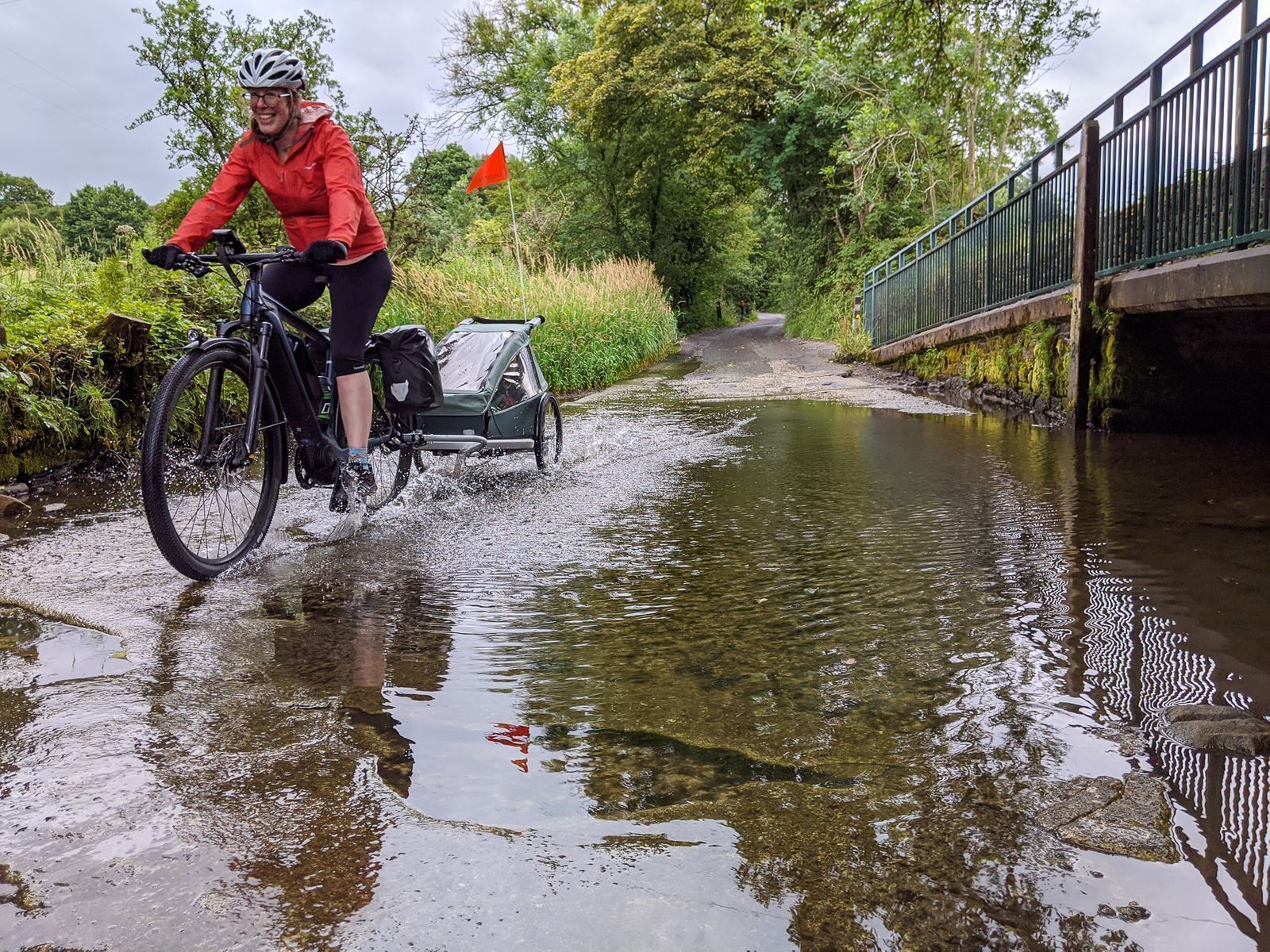
This content would usually be for Members only. If you find it useful or you enjoy it, perhaps you’d consider joining us? Or, check out our web shop and support our work by making a bike related purchase from us.
As a brand, Canyon does a few things very well. It puts out-there ideas into the wider world (who could forget Hoverbars?), and its bikes also tend to be incredible value for money. Canyon also makes bikes that cater to a particular market. One look at the Pathlite:On and it’s clear that it’s aimed at the sort of customer whose ride preparation tends to involve filling up a Thermos flask rather than pulling on kneepads. But while a lot of touring bikes seem to be deliberately unadventurous, Canyon has equipped the Pathlite:On range with full fat 29er tyres, mountain bike components, and 100mm suspension forks, hinting that it might be more fun on the rough stuff than some of its ilk. Then there’s the extra fun potential of the electric assist, which promises to make a fully laden excursion as easy as a regular ride. And finally, it’s the only model in the Canyon range which is designed to tow a trailer, meaning that if you want to drag Junior along on a ride, this is your safest option.
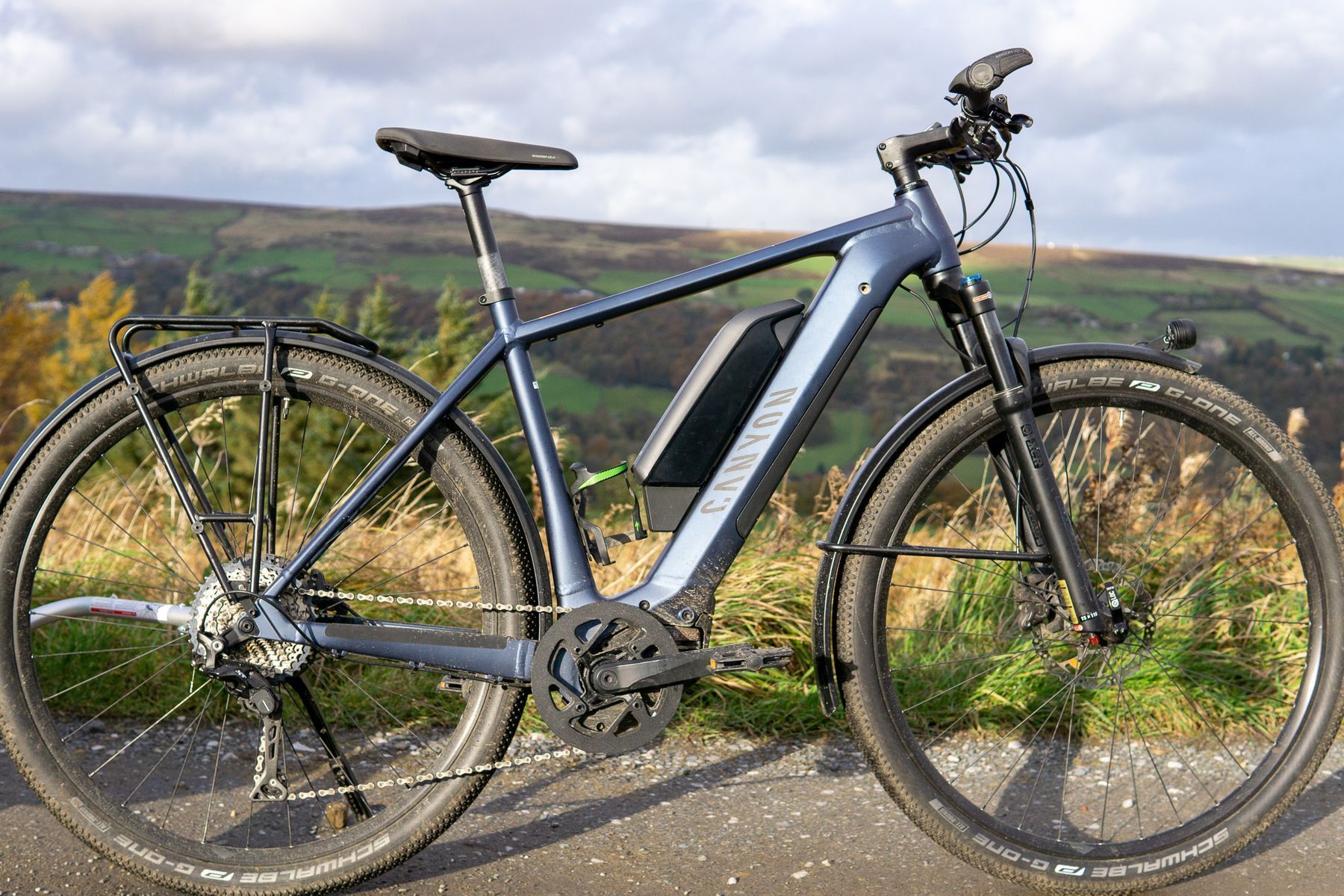
The Bike
The Pathlite:On 8.0 sits near the top of a range which starts well below the £3k mark. All the variations of Pathlite:On sport the same frame and the same range of accessories. The European approach to utility bikes, where your initial purchase also includes everything you’d want to add on later, is still catching on in the UK, but it makes sense, as you know you’re getting a full set of accessories that are designed to work together.
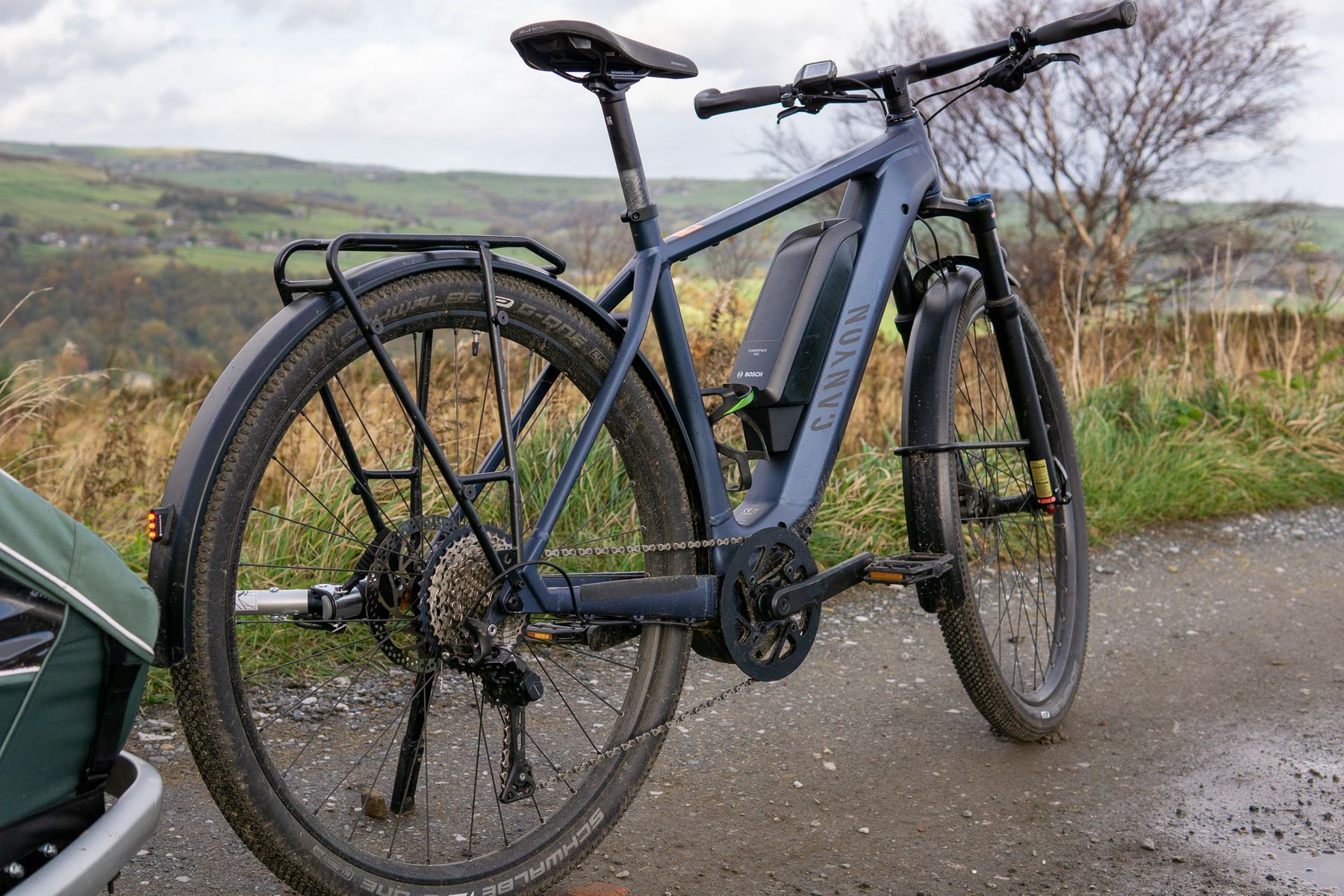
So the beefy alloy mudguards feature built-in light mounts and channels for hidden wiring; the kickstand (yes, this bike has a kickstand) bolts directly to mounts in the chainstay; and the integrated bar and stem has a couple of hidden bosses for an out-front smartphone or GPS mount. You also get a decent pair of low-profile plastic pedals which don’t have pins, but are grippy enough for gentle off-road. While a fully accessorised touring bike is never going to look particularly clean and uncluttered, the Pathlite:On could have been much more of a dog’s dinner. Even the Knog bell is neat.
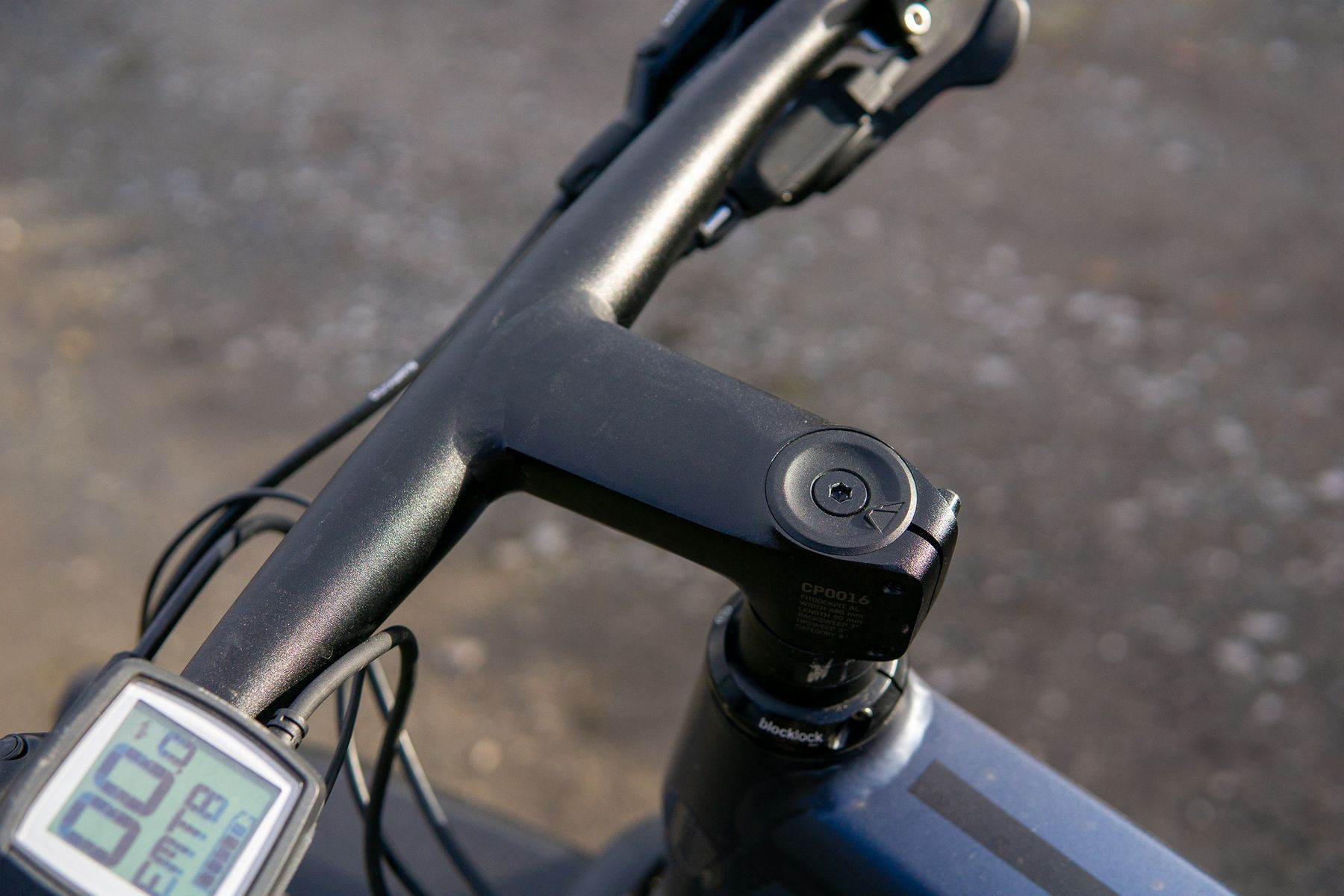
Underneath all that kit is a chunky aluminium frame with a high riding position and a very short reach, by the standards of modern mountain bikes. The assist system is Bosch’s well-proven Performance Line CX, coupled with a no-frills Purion controller. This version of the Performance Line has the all-in-one “EMTB” mode, meaning you can get anything from a gentle push to a full-on shove from the assist, depending on how much effort you put in yourself. There’s one 500Wh Powertube battery in the downtube, and a second external battery above it. The batteries are designed to be used together, making multi-day rides or a week’s worth of commutes with no charging a real possibility. Both batteries charge via a single port in the seat tube, or can be removed and charged separately if you prefer.
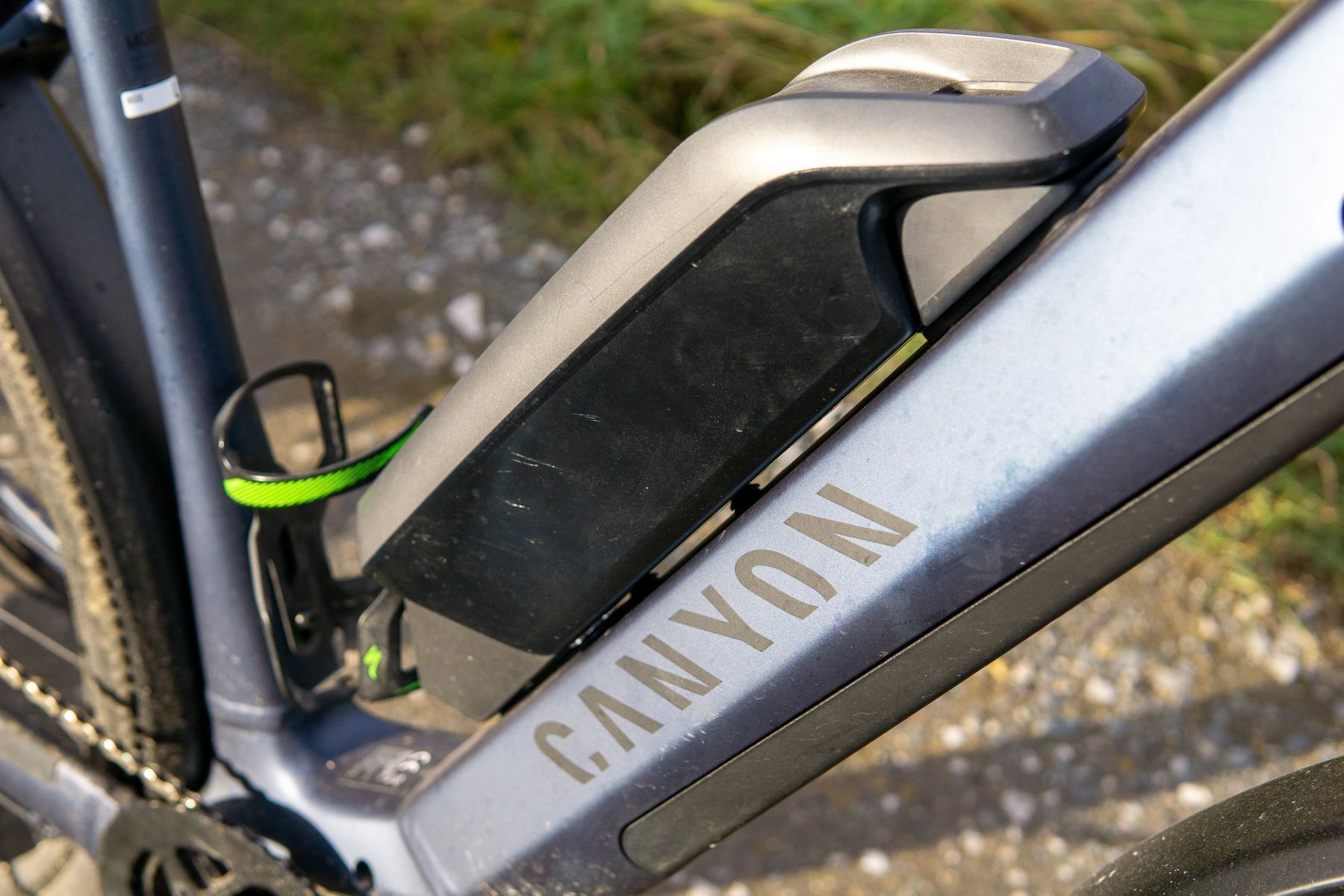
You can also remove the upper battery to save some weight, or even to bail out a stranded friend with the same assist system. Detaching the battery reveals a third set of bottle cage mounts, but also exposes the electrical contacts, so really filthy rides without it fitted might be inadvisable. If you have both batteries fitted, the Bosch system draws on them simultaneously, which should help prolong their life.
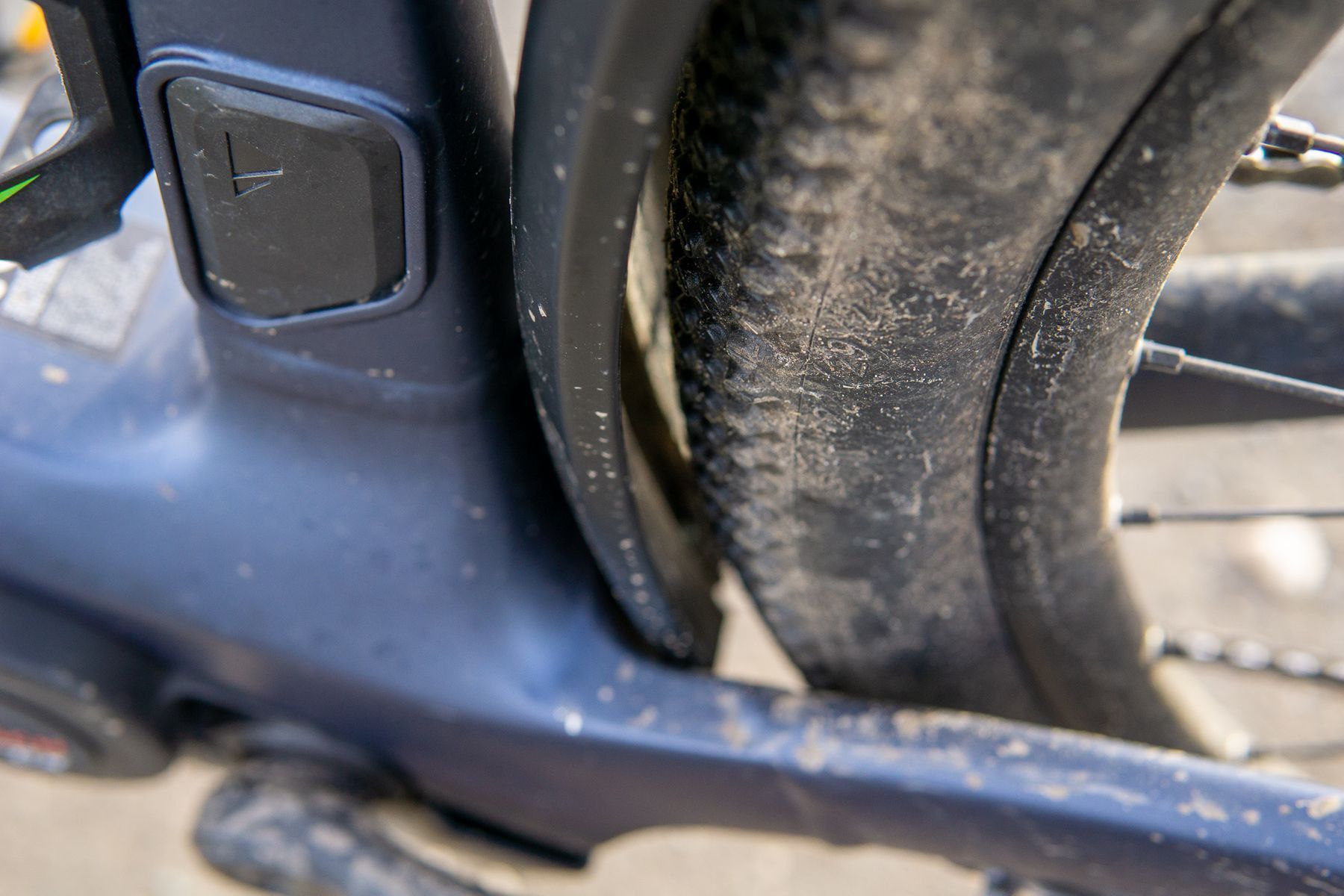
The drivetrain and brakes on the Pathlite:On are mostly drawn from the Shimano stable, featuring an XT rear derailleur, SLX 11-speed cassette and shifters. Brakes are Shimano’s cheaper MT500 Deore units with resin pads (although they still feature the shorter lever of its higher-end brakes), paired with 180mm disc rotors. To mix things up slightly, the bike is equipped with an FSA chainset sporting a decent sized 42T ring. This gives a fairly tall 1:1 bottom gear, which might be worth bearing in mind if you’re trying to match pace with an unassisted rider.
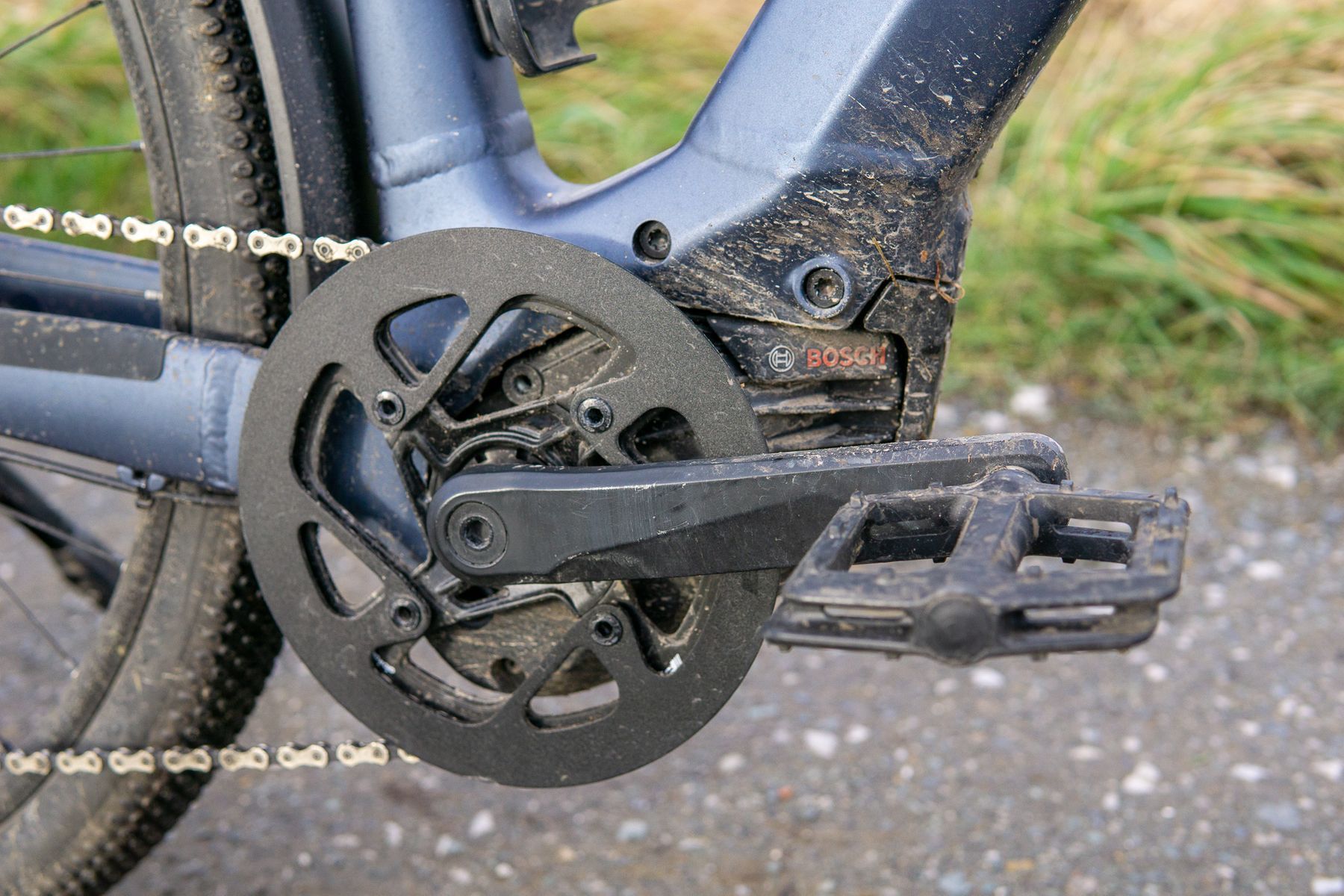
Unless you go for the smallest size, all of the Pathlite:On range roll on 29in wheels with tubeless-compatible Alex rims. Schwalbe’s fast-rolling G-One tyres are a fixture of the gravel scene, but here they’re scaled up to a 2.25in mountain bike size. They don’t arrive set up tubeless, and given the bike’s intended use I opted not to do this for the review.
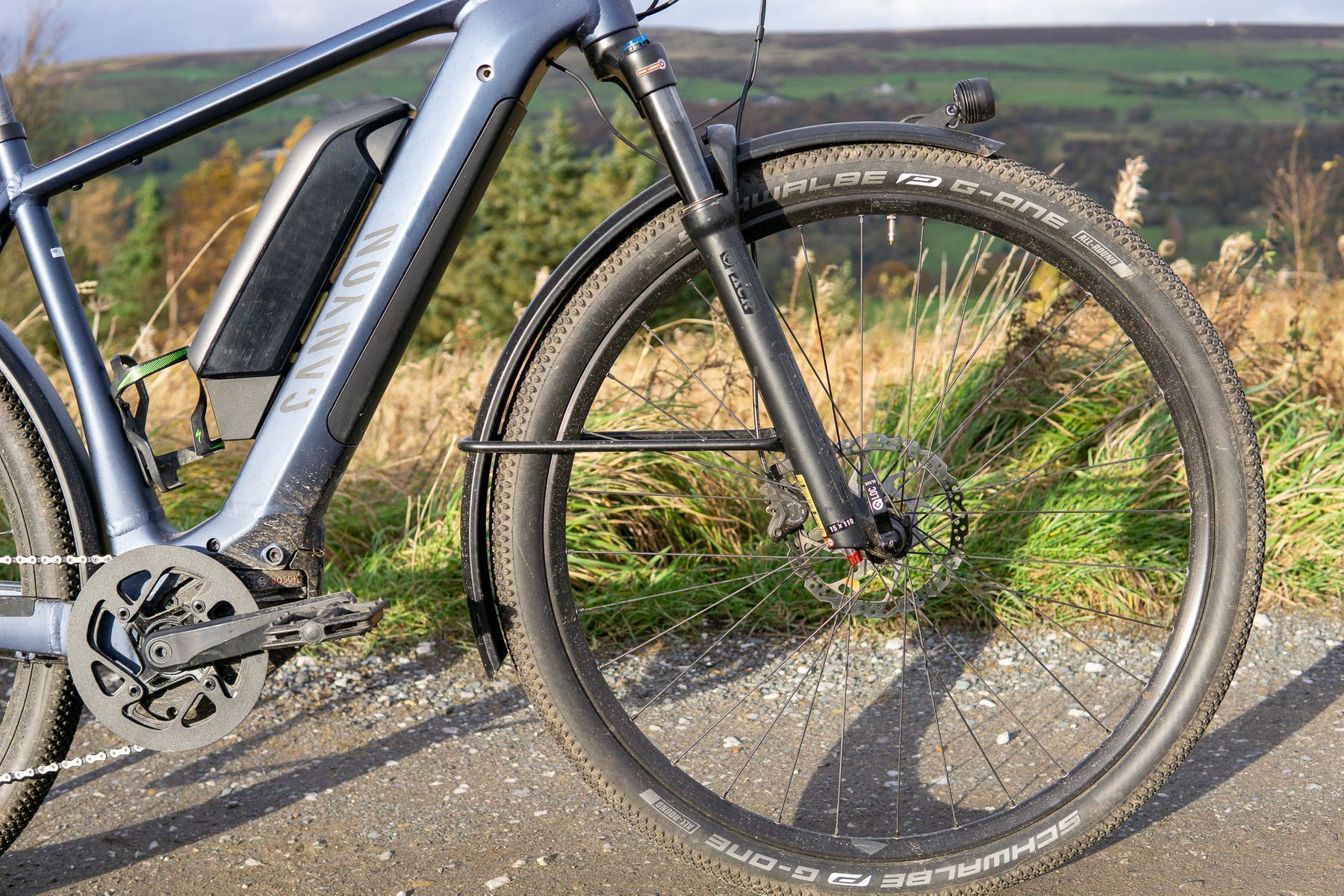
SR Suntour supplies the front suspension. The XCR34 forks feature a stiffer 34mm chassis for ebike use, and a 15mm thru axle with the nifty tool free Q-LOC system. This is a bit more secure than some bolt-up axle designs, as there’s an extra retention system on the non-lever side which needs a quick push and turn to disengage.
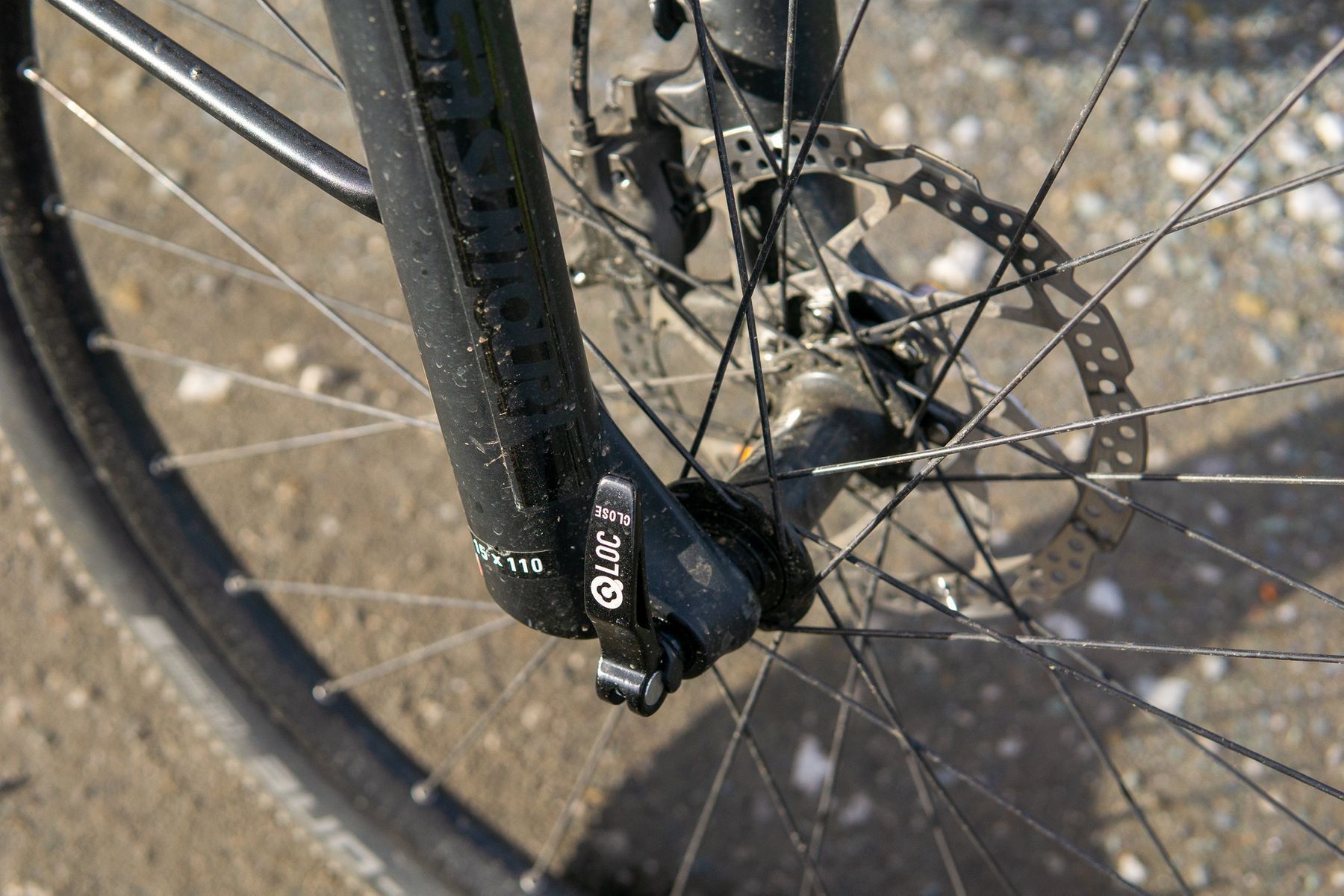
Contact points are mostly from Canyon’s own range. There’s no option for a dropper post, another sign that we’re firmly in touring territory, as are the Ergon grips and stubby bar ends. All the Pathlite:On range get Canyon’s CP16 integrated cockpit, which is a 90mm stem and 680mm bars rolled into one. It’s cleaner and stiffer than some of the adjustable monstrosities found on hybrid bikes, but potentially a bit annoying if you want to use your own handlebars or stem. Fortunately all the handlebar cabling is external, so you can swap cockpit parts without having to retrain as an electrician.
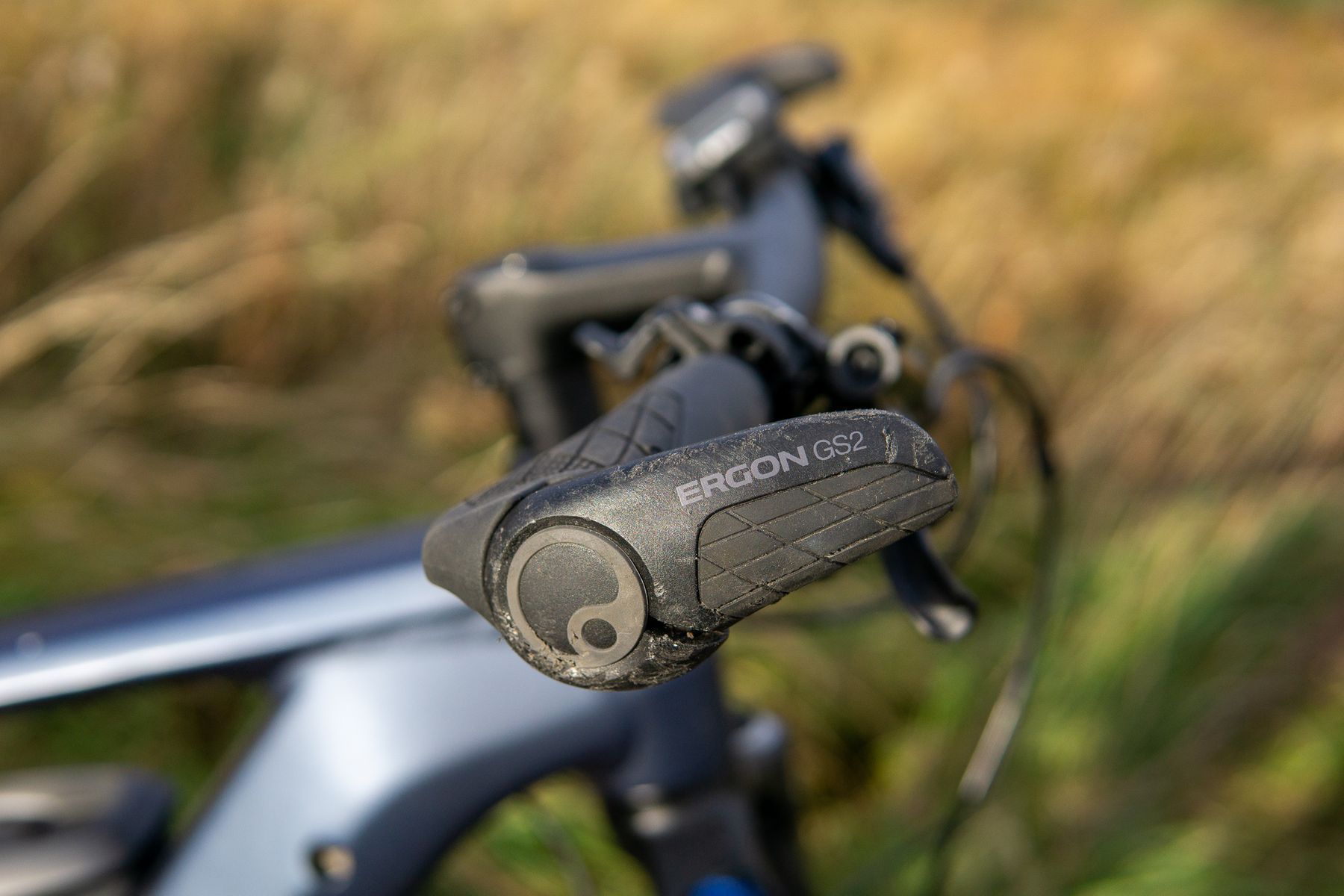
The Ride
Let’s get this out of the way: riding the Pathlite:On on full-blown off-road trails is a bit like trying to go rallying in a milk float. However it’s very much at home on the sort of terrain where you’d take a gravel bike, and is still capable when things get rougher. The Bosch assist system delivers a whole lot of power and torque, but thanks to the fat tyres it’s kept under control, meaning you can happily tick off quite techy climbs.
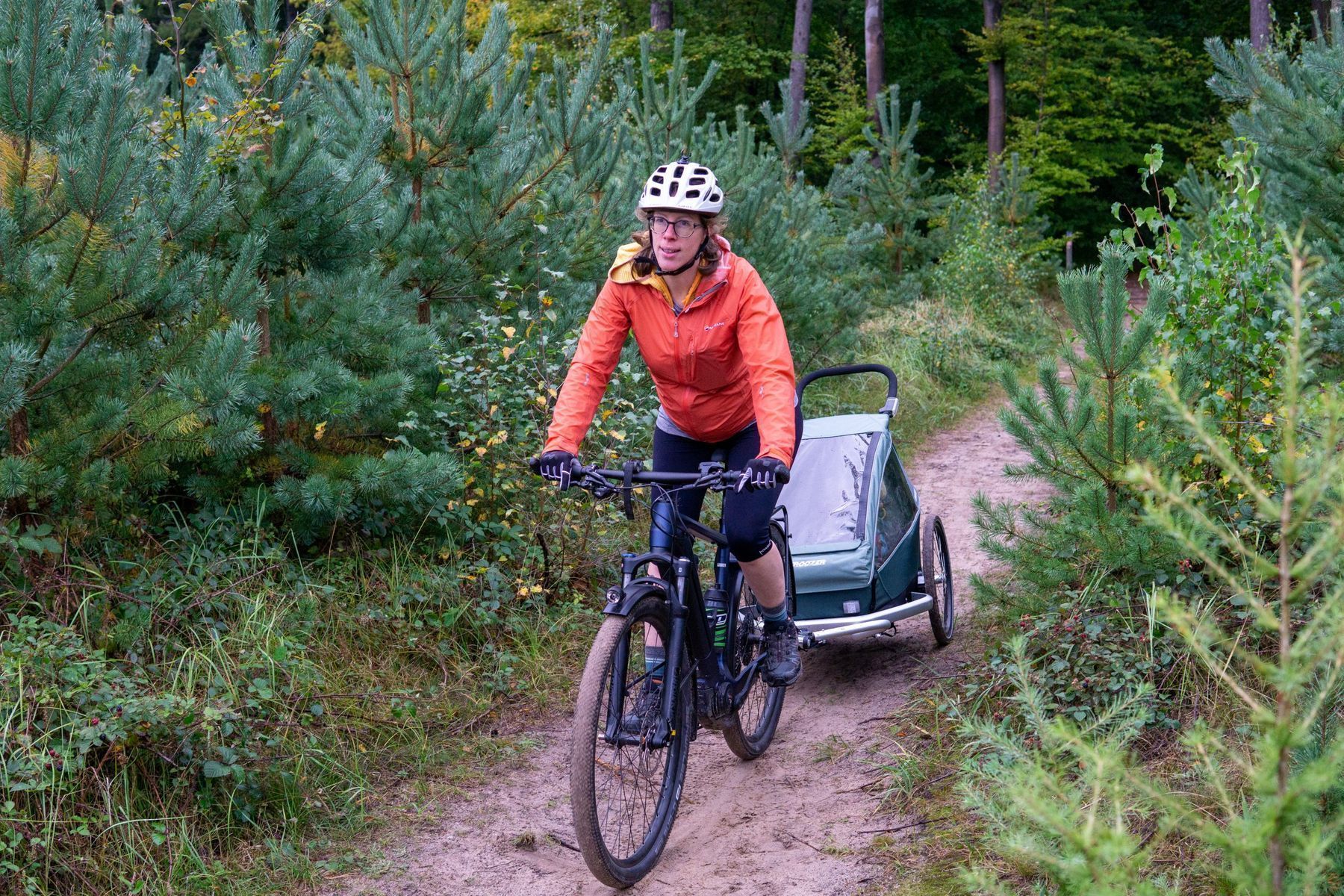
Off-road descents, unless they’re nice smooth ones, are better taken steady. The 1990s geometry and narrow bars don’t encourage you to push the bike much, and the forks are nice and stiff, but lack a bit of support. Speaking of stiffness, the back end of the frame is also quite unyielding, something that going tubeless or fitting a suspension seatpost might help to alleviate. The Schwalbe G-One tyres have a surprising amount of grip, although a tread with a more defined edge might be better suited to our muddy little island. Having had one puncture, I also wonder if a tougher casing might suit the long haul aspirations of the bike better.
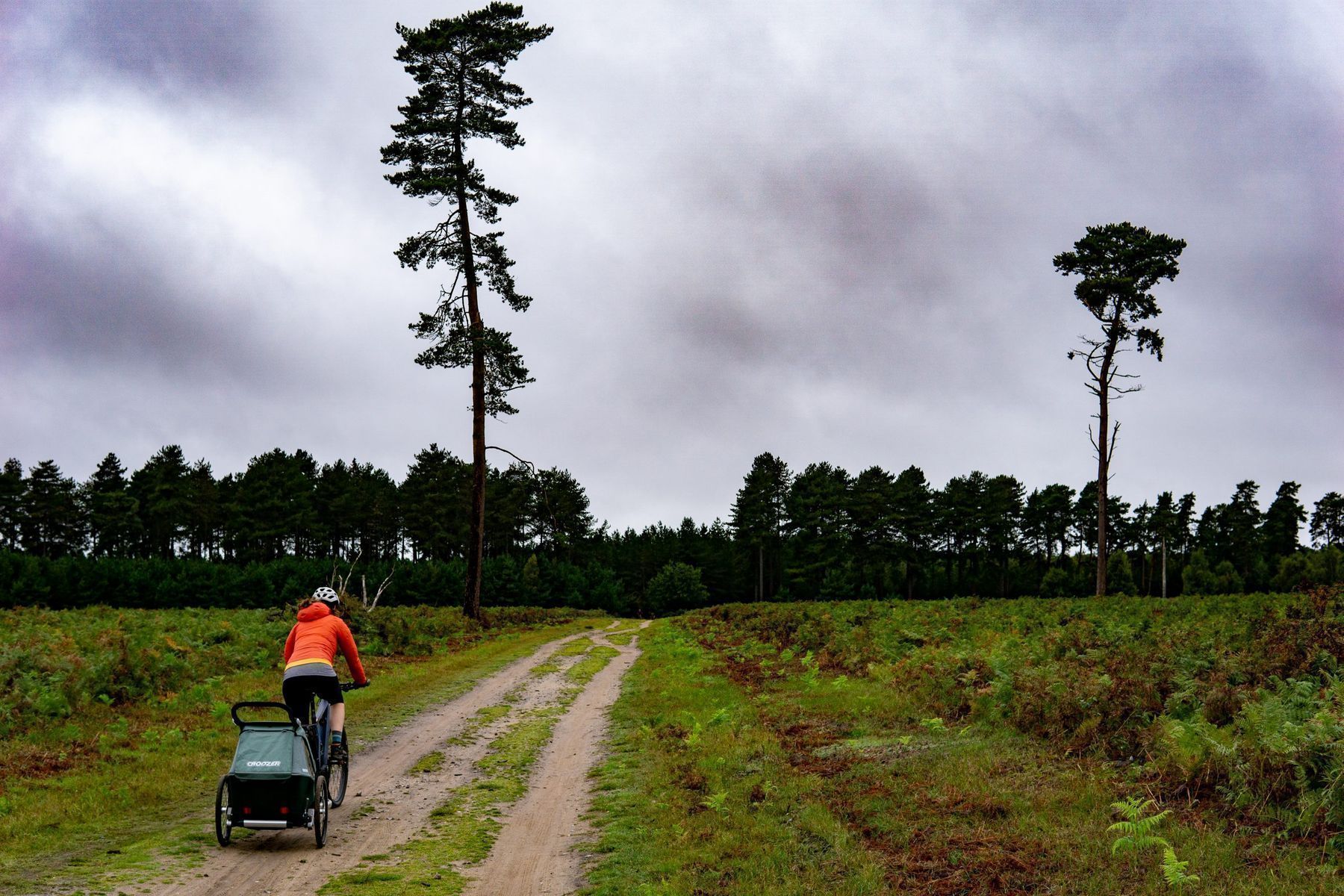
The Shimano drivetrain performs as well as you’d expect. Despite being a few tiers down the range, the brakes are also decent enough. The rotors took on some interesting colours after a particularly long, fast fully laden road descent in the Yorkshire Dales, but they kept working, although the brake pads are ready for a change after a few hundred miles.
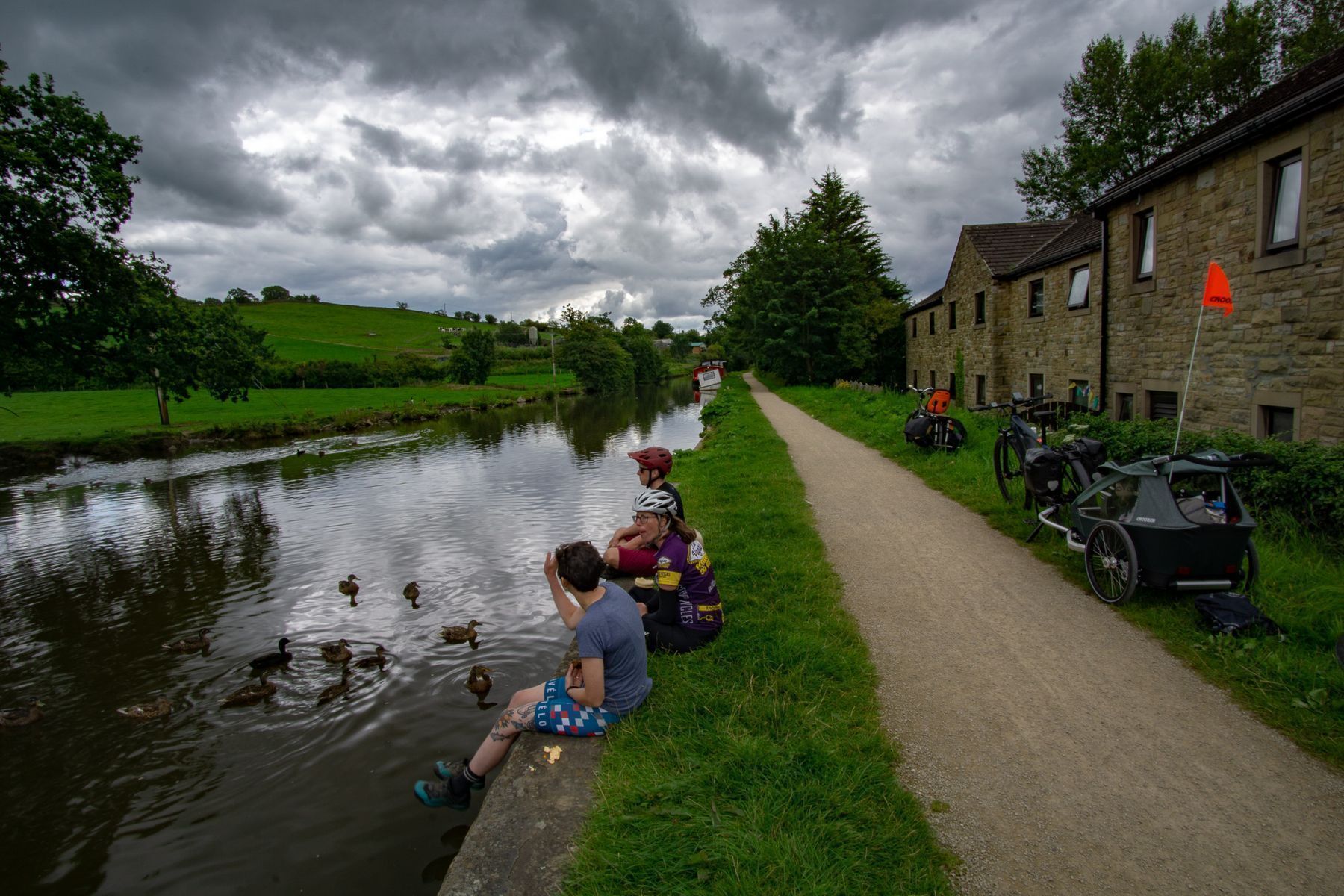
For the Pathlite:On 8.0 to come into it’s own you’ll need to load it up, or hitch it to a trailer. The steel rear rack has nary a trace of twanginess, and has neat little rubber buttons to stop you wearing holes in your panniers. The full mudgards are also excellent, and do a great job of keeping the muck off. Their thick alloy construction means they’re also sturdy enough to survive a few stick or stone encounters without cracking in half.
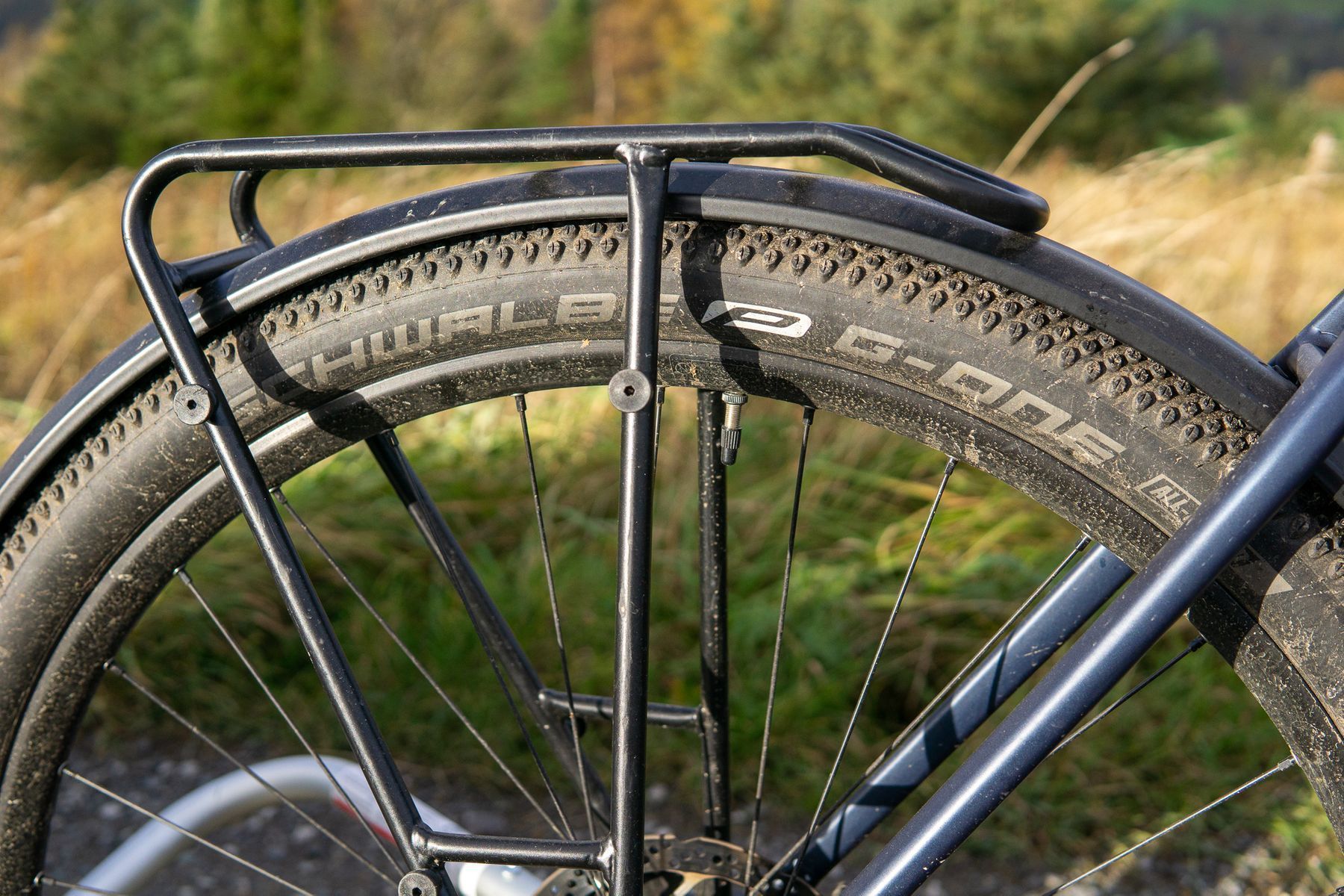
The dual beam Supernova headlight is another great bit of kit, with one setting for road and a wider full beam that’s easily bright enough for off-road. It’s let down slightly though by the repositionable magnetic dip switch. The bracket spins on the bars easily, making it hard to press the button, and on rougher trails the button tends to separate from the mount and ends up dangling on its wire like a fishing lure. There’s also no indicator as to whether you’re on high or low beam – ok at night but during the daytime you might end up dazzling oncoming traffic.
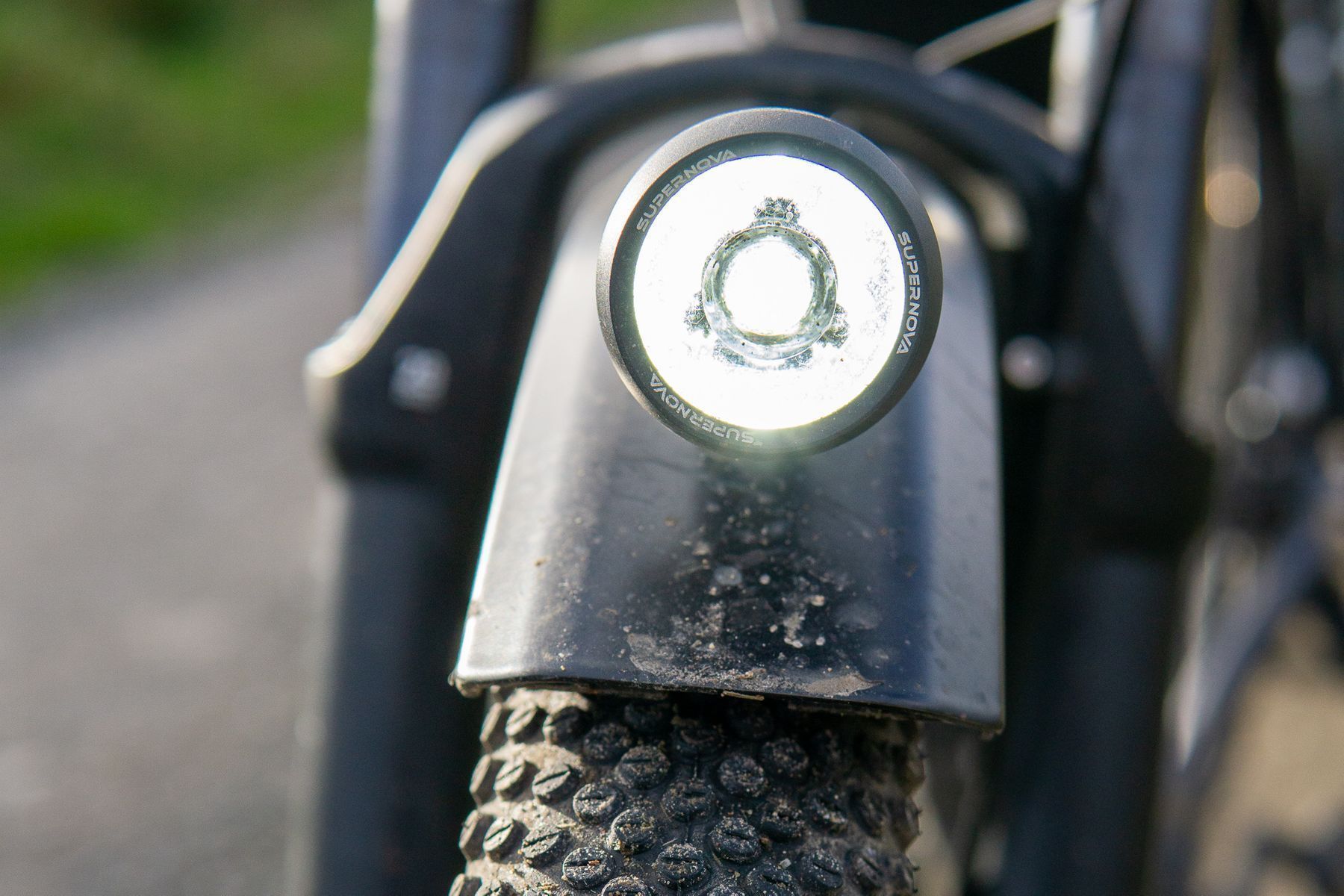
I also didn’t get on particularly well with the kickstand. The weak spring makes riding rough trails a rattly affair, and while it’s useful enough when hitching up a trailer, single-sided stands of this type aren’t great for heavier bikes – you really need a nice level bit of ground for it to work happily. A centre-mounted double stand would offer a more stability at the expense of a bit of ground clearance and weight.
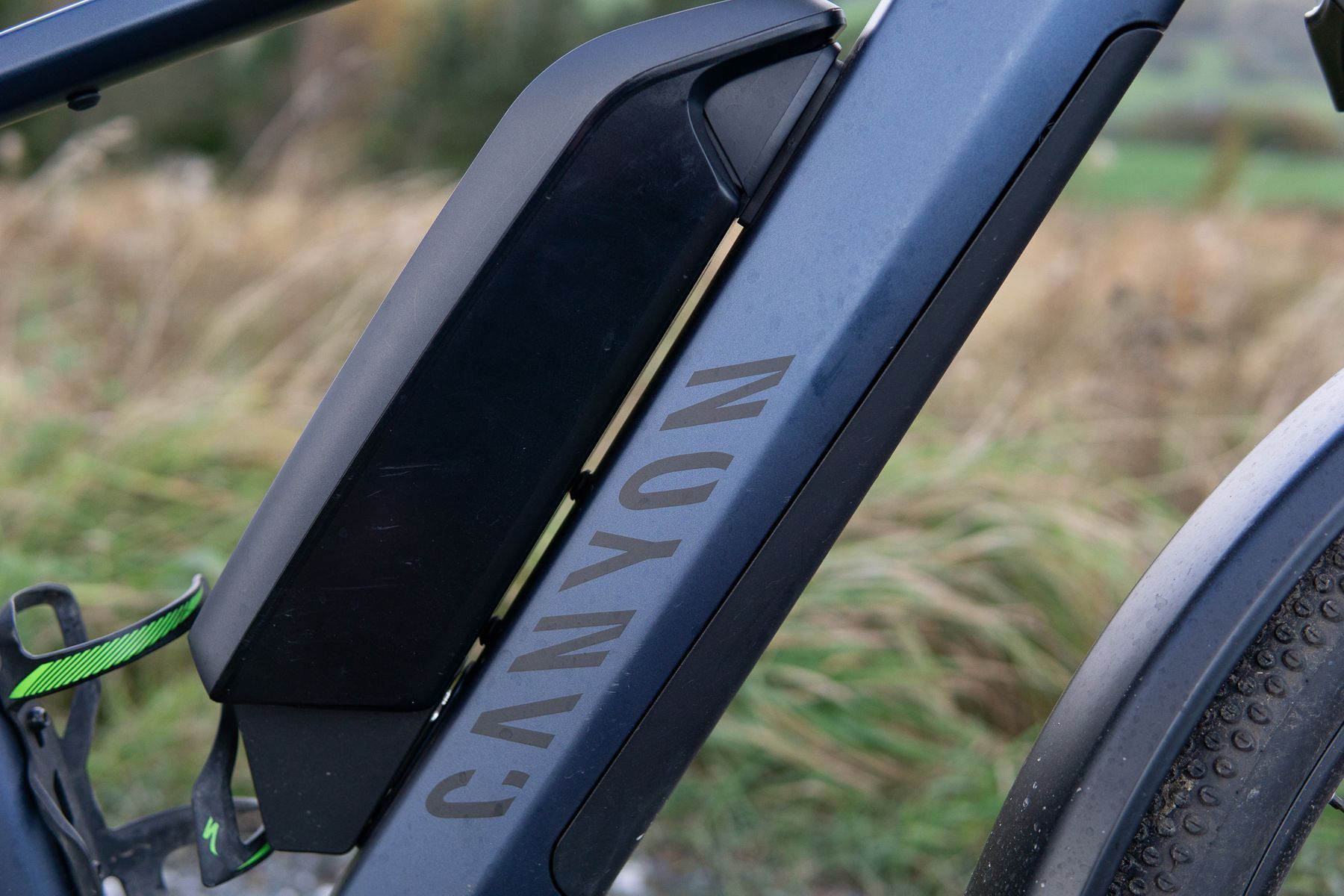
Speaking of weight, the dual battery version of the Pathlite:On is packing plenty of it, and even as a relatively young, able-bodied person I found getting it up steps or into the car a bit of a workout. The high top tube would also make mounting and dismounting a challenge for anyone with limited lower body mobility. The trade-off, thanks to that extra battery, is range, and loads of it. Long, hilly rides, even fully loaded, are no longer an exercise in range anxiety and even after 30-mile days hauling a fully loaded trailer and panniers, there was still plenty of charge left.
Durability Notes
With a bike that’s designed to be used for long-range excursions, you want to be sure it’s going to stay in one piece, and three months and 600 miles with the Pathlite:On didn’t expose any serious concerns over its long-term durability. The own-brand finishing kit has started to look slightly tatty, and a set of mudguard bolts shook loose on a longer ride, but functionally everything is still working as well as the day it arrived.
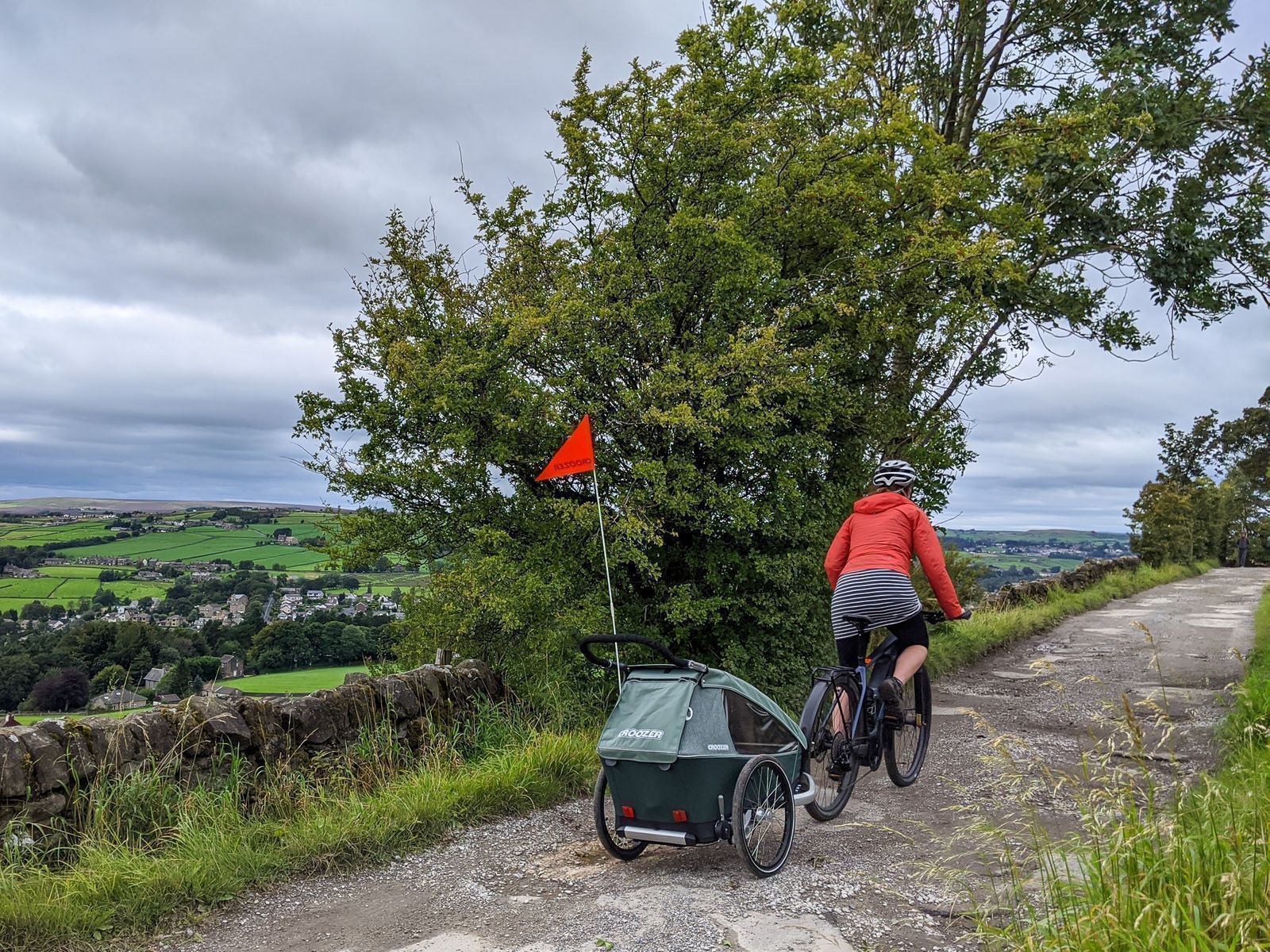
Three Things That Could Be Improved
- It would be nice to see more off-road friendly geometry in addition to load hauling capability.
- The extra battery and accessories mean the cost – and weight – are probably a bit much for a lot of riders. The range does include some much more affordable models though.
- Tougher, mud-friendly tyres would suit the UK better.
Three Things That We Loved
- It’s great at hauling heavy loads.
- The accessories, particularly the lights, are top quality and genuinely useful.
- You can do a proper long ride without having to think about the battery life.
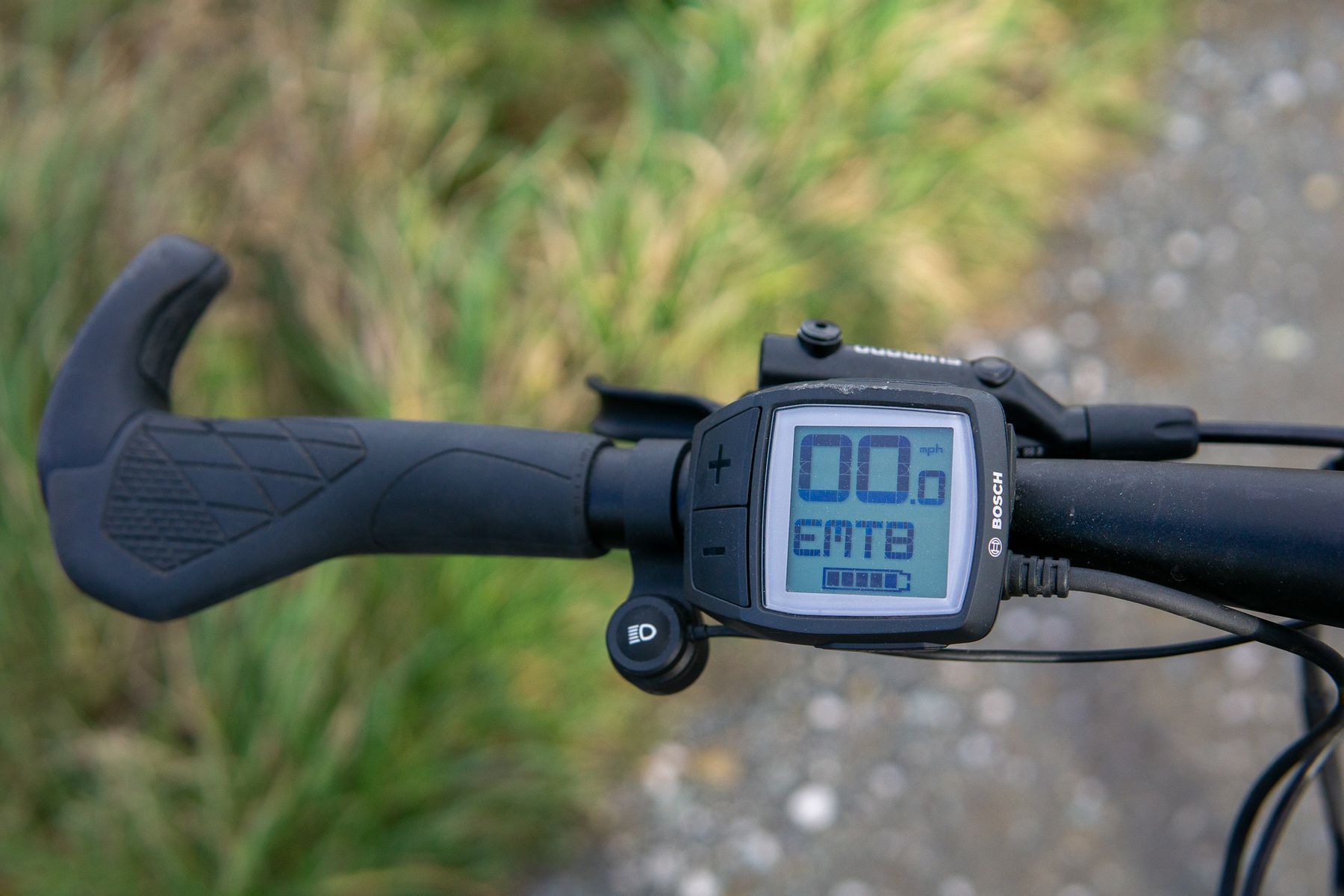
Canyon Pathlite:On 8.0 Specification
- Frame // Canyon Pathlite:On aluminium
- Front Suspension // SR Suntour XCR34 Air
- Wheels // Alex MD25 rims, Shimano MT400 hubs
- Tyres // Schwalbe G-One Allround 57 mm
- Shifter // Shimano SLX 11-speed
- Rear Derailleur // Shimano Deore XT M8000 SGS
- Crank // FSA CK-220 GEN4 ISIS
- Cassette // Shimano SLX M7000 11-42
- Saddle // Fizik Essenza
- Seatpost // Canyon Iridium
- Handlebar // Canyon CP16 Cockpit, 680mm
- Stem // Canyon CP16 Cockpit, 90mm
- Headset // Acros
- Brakeset // Shimano MT500, 180mm rotors front and rear
- Grips // Ergon GS2
- Assist // Bosch Performance Line CX (Gen4)
- Battery // Bosch PowerTube 500 Wh/Bosch PowerPack 500 Wh
- Controller// Bosch Purion
- Display // Bosch Purion
- Lights // Supernova Mini Pro 2
- Rack // Ortlieb QL3.1
- Sizes// S,M,L,XL,XXL
- Claimed Weight// 27.04kg/59.5 lbs size medium, no pedals.
- Price // £4,099
Overall
It’s not really a mountain bike, but the Pathlite:On does exactly what its target market are likely to ask of it, with some aplomb. It’s great at lugging loads, the range from the double batteries makes proper all-day rides a possibility, and if you want to tow a trailer (more of which in a moment) the assist system has more than enough power. At heart it’s very much a hybrid though, which means my fantasy e-bikepacking bike – one that eats up technical trails while carrying a load of gear – is still out there, waiting to be found.
The Trailer
Canyon supplied the Pathlite:On 8.0 with a Croozer Vaaya 1 trailer, designed for carrying children under 6 years old. Since our daughter entered our lives we’ve become huge trailer fans, and our own has been very well used, with a couple of caveats. It’s too wide to take on a lot of trails you’d go mountain biking on, and getting it through barriers and gates can be a two person job. It’s also a bit of a faff for everyday journeys, as unless you’re blessed with an abundance of bike space you’ll need to unhitch and dismantle it for storage. However, if you have the appropriate accessories (usually some sort of insert for the seat) you can start using a trailer earlier than a bike seat, as most of the latter don’t work for children under 1. A two wheel design also means a trailer can be used independently for trips to the park and the shops or, if you fit an optional jogging wheel, taking your little darling along for Parkrun.
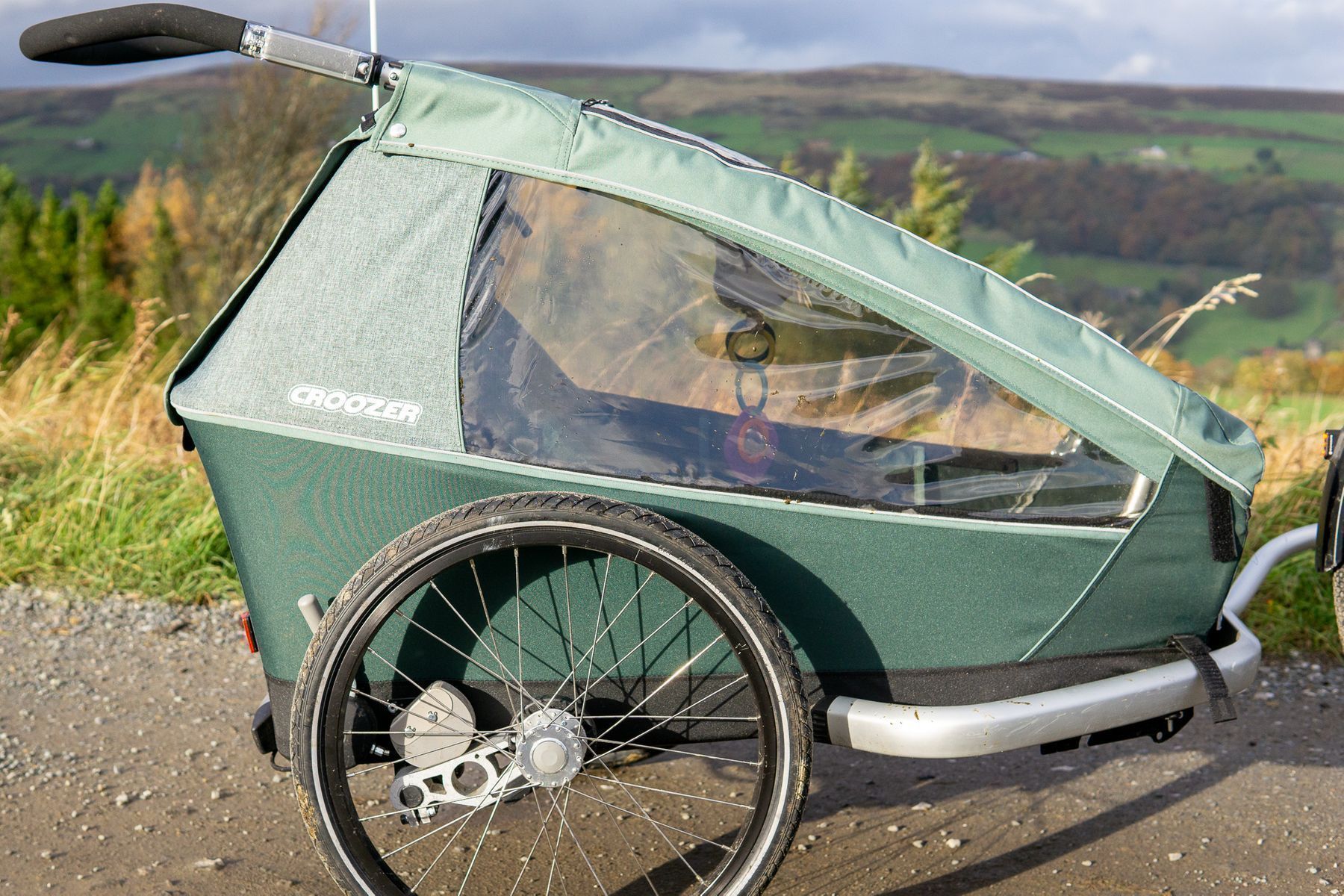
The Croozer Vaaya is entering quite a crowded marketplace, but it has a few tricks up its sleeve. First of all, it boasts a very sturdy looking aluminum chassis that looks like it could survive being clattered off a few rocks or anti-moped barriers. The profile of the trailer is a tad narrower than some, and it also has a very low centre of gravity, making tests of the built-in roll bar less likely.
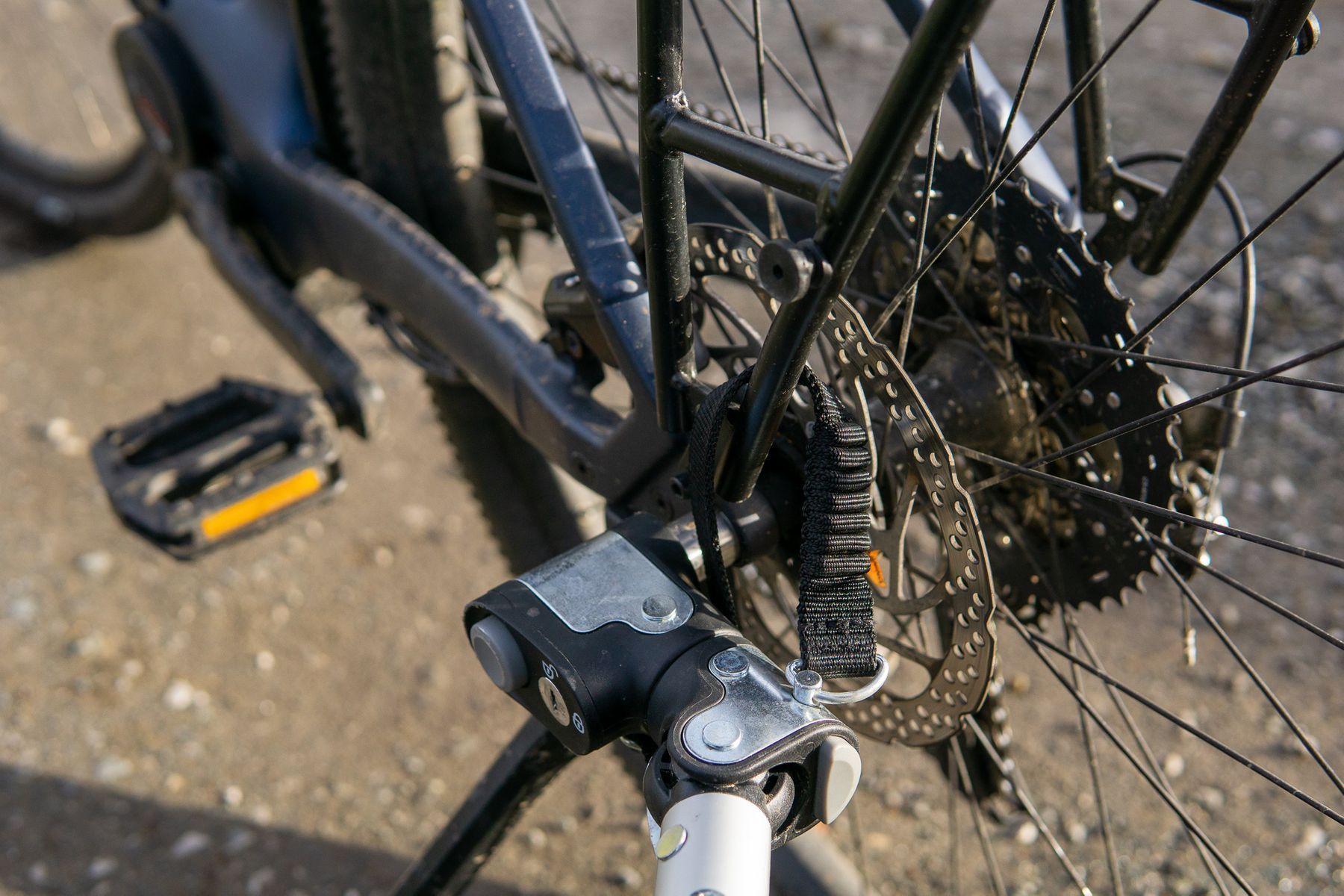
The trailer attaches via a sturdy alloy hitch arm at the axle of the tow bike, which requires either a universal QR mount or a specific thru-axle for your bike. There’s a safety strap and a nice positive click as it engages. It can be a bit reluctant to detach however. One feature of trailers designed in Europe is that they tend to be offset to the left hand side – not by much, but it’s something to bear in mind if you don’t want to lose a wheel off the edge of the trail or road.
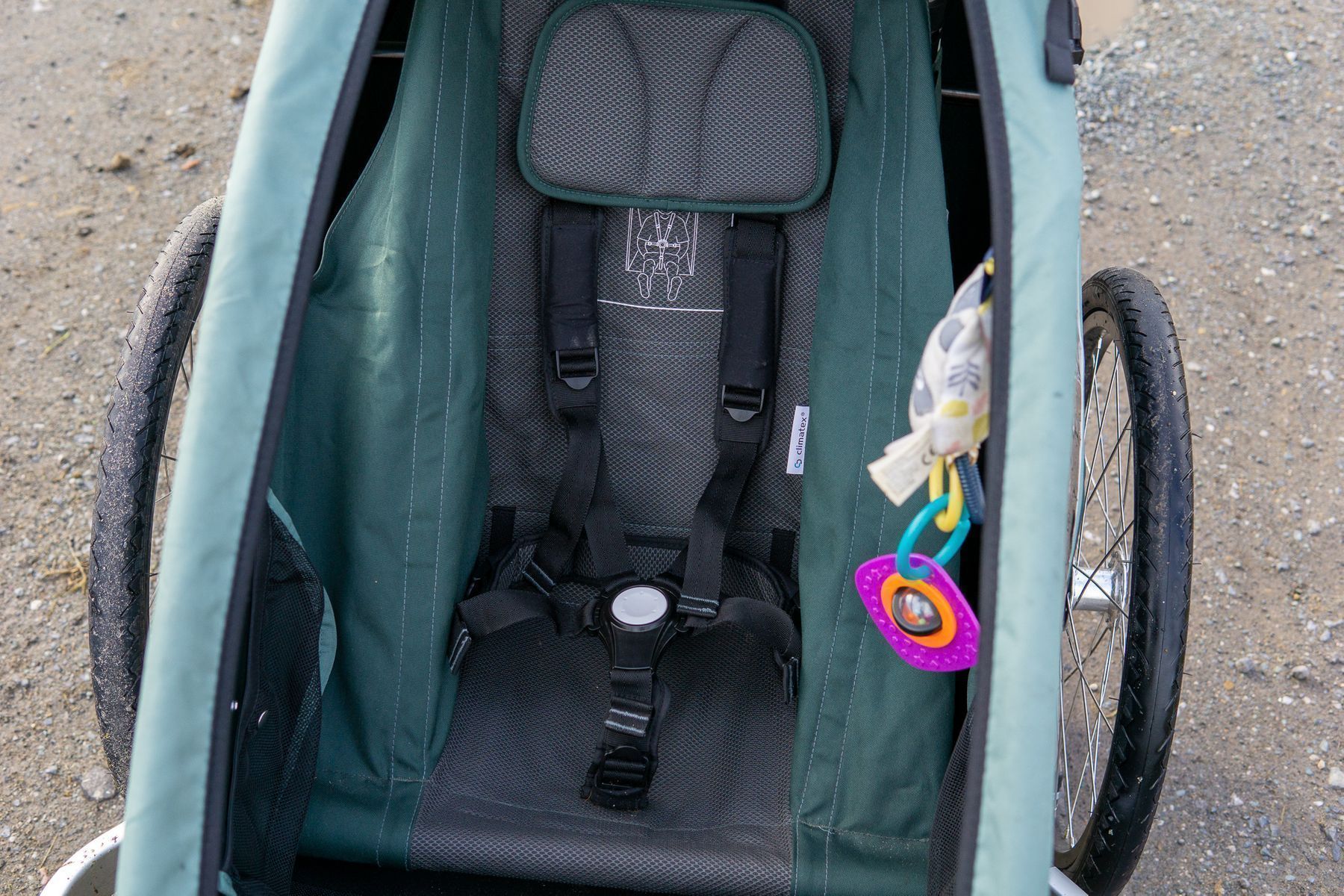
Lashing your offspring down is easy thanks to a five point harness with separate clips, which makes me wonder why all child seats don’t have this. There are a couple of handy mesh pockets for toys and snacks. The front half of the trailer is fully waterproof, with the option to roll up the cover on dry days. There’s also a boot which adds a decent amount of luggage capacity. Croozer claim it holds 43 litres, although the frame of the trailer reduces this somewhat in practice.
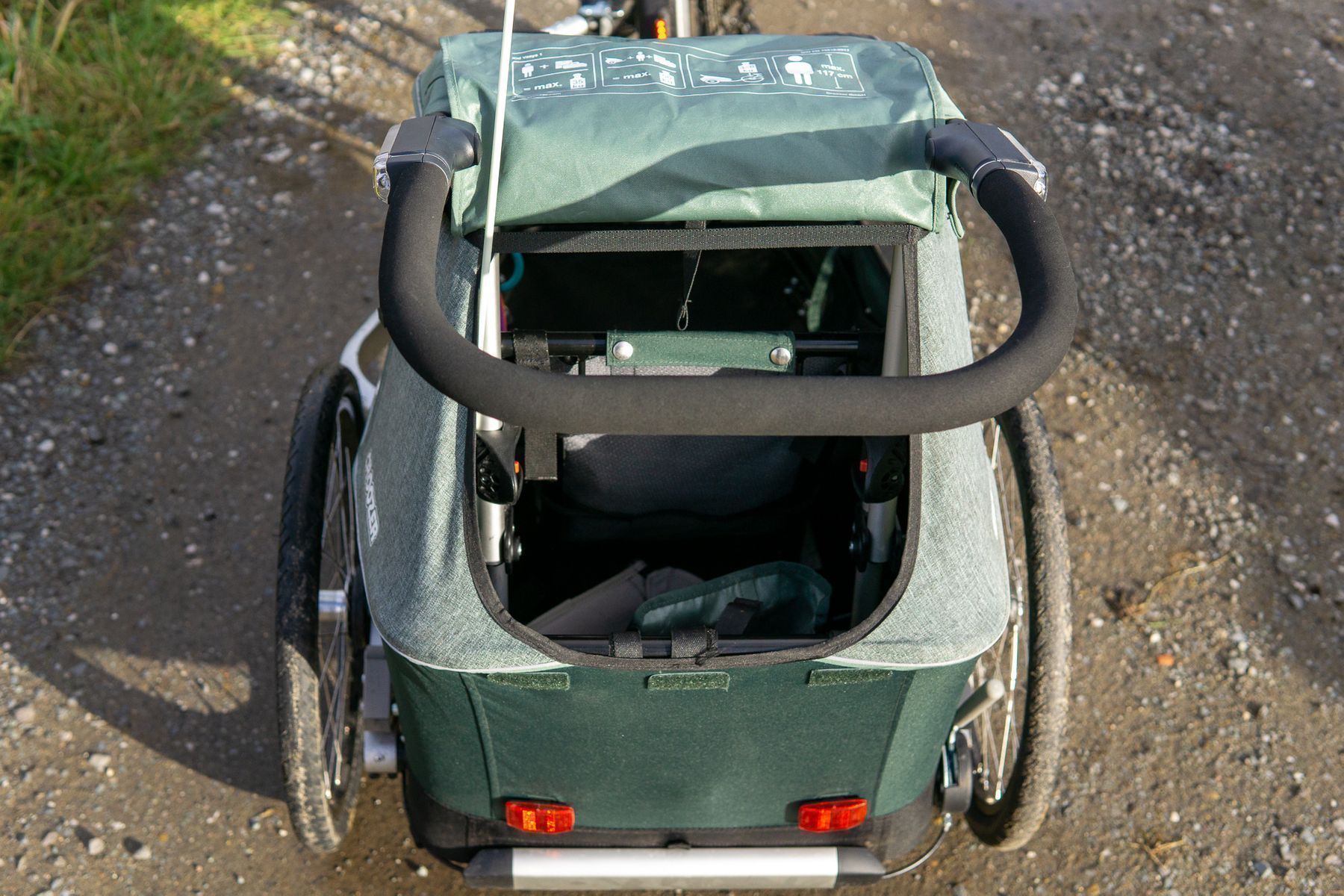
The Vaaya also features elastomer style suspension, dubbed “Airpad”. This adds a bit more comfort to the ride, and according to Croozer it’s self-adjusting, so you don’t have to reset it when you swap passengers or put more weight in the boot.
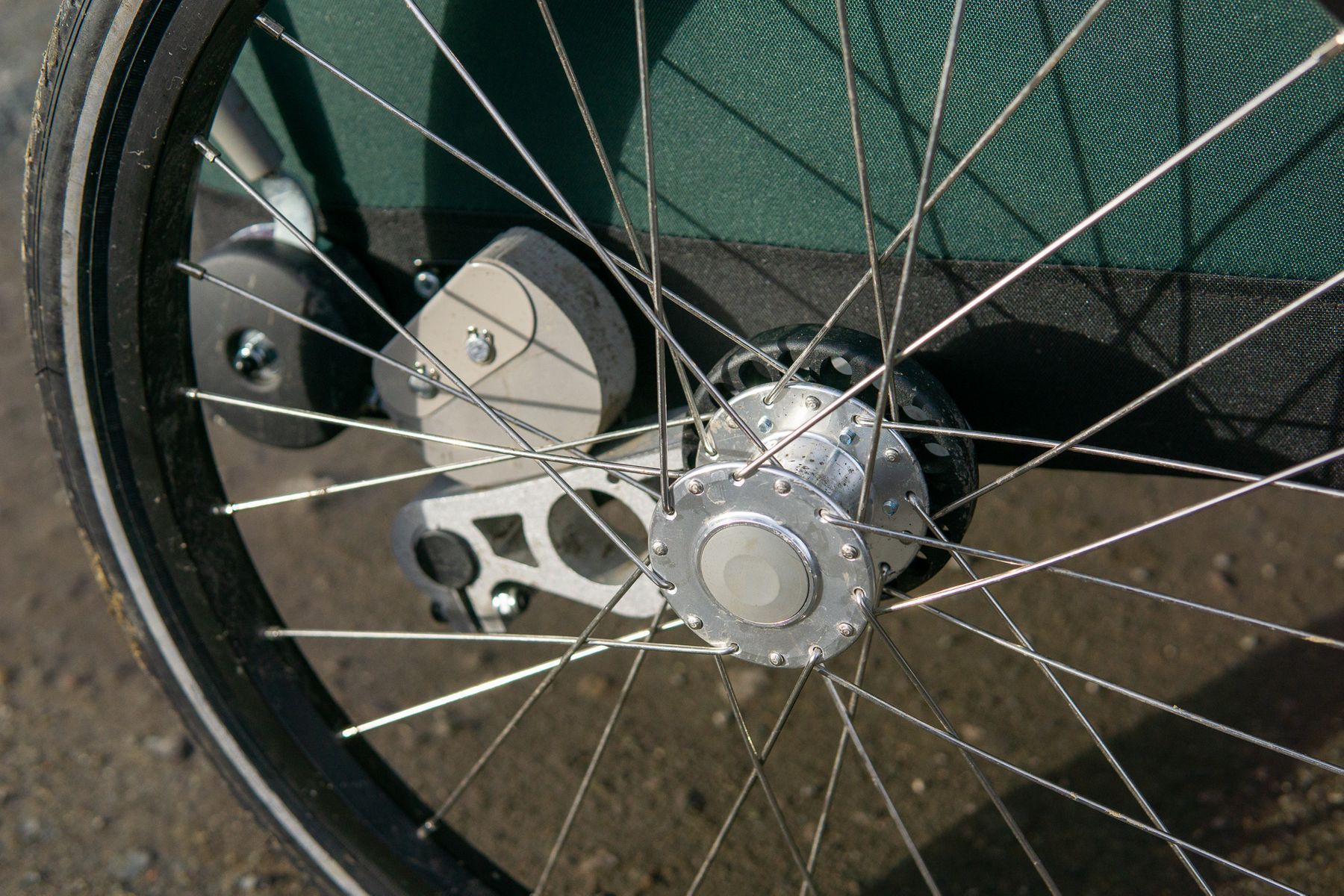
For storage, the hitch arm and wheels detach and the trailer folds flat. When it’s dismantled like this, it’s around six inches thick and can fit into a cupboard or hang on the back of a door.
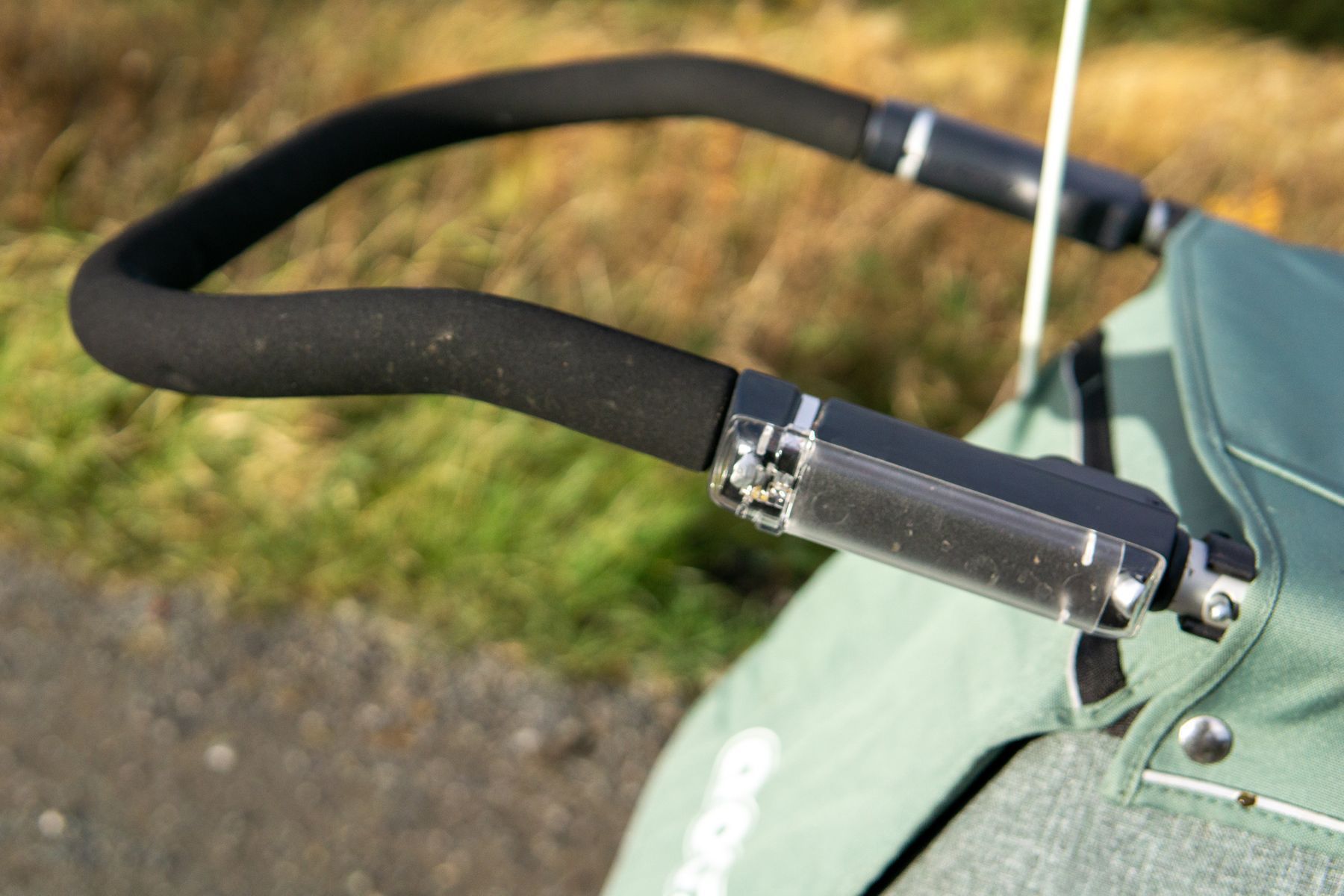
The Vaaya is rounded off with a few neat safety features, including front and rear reflectors and side lights that come on automatically when they sense it’s getting dark. The trailer also comes with everything you need to use it as a buggy. We tended to leave the push handle attached, partly due to the aforementioned lights, partly because it makes it easier to manoeuvre a laden trailer through the gates and barriers that afflict typical British cycling shitfrastructure. The other necessary element is a dinky wheel that clips into the underside of the trailer at the front edge. It even comes with its own little pouch in the trailer boot, which means you can sling it in there and keep it handy.
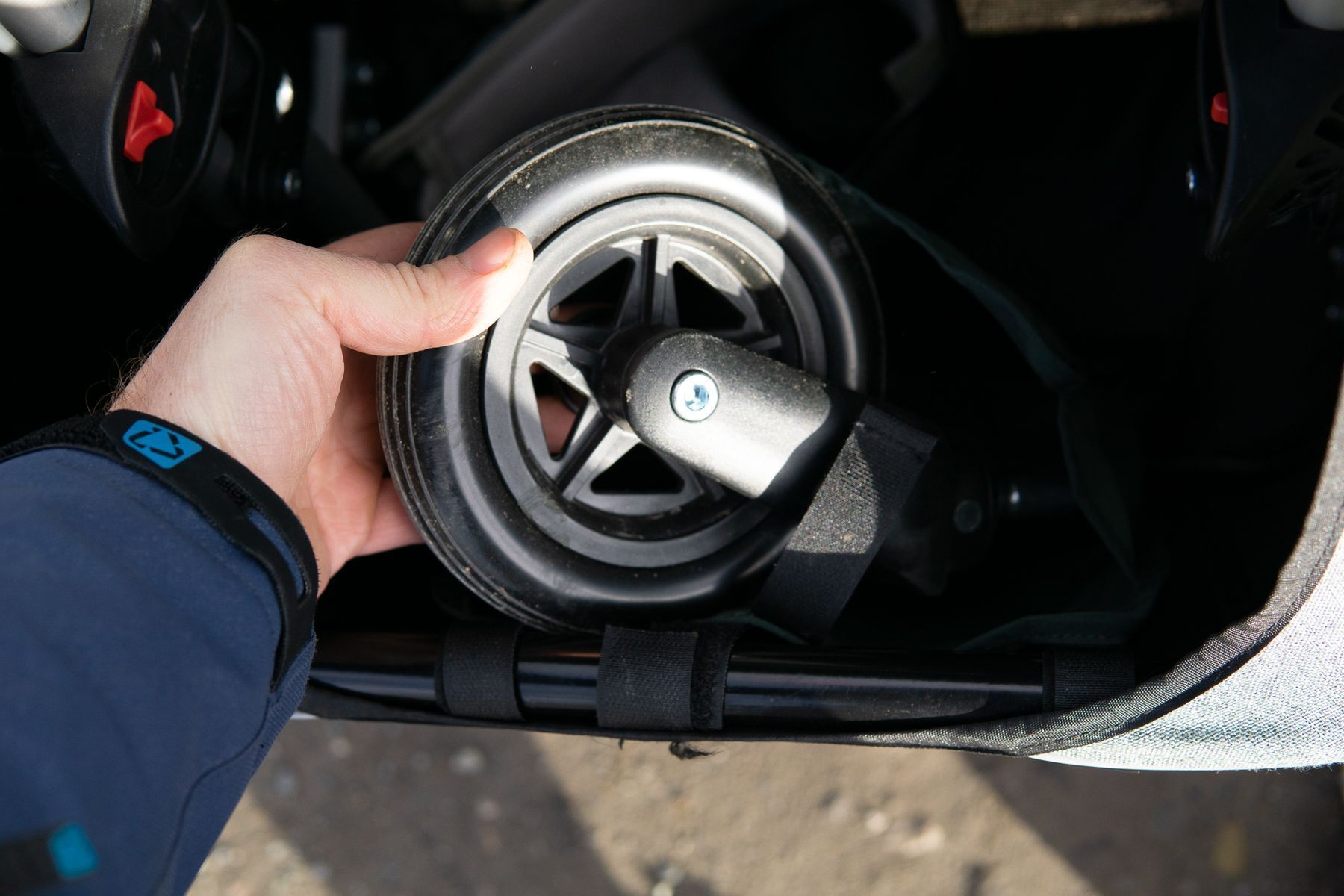
In use, the Croozer Vaaya is as nice as any trailer I’ve towed. The low centre of gravity keeps things super stable and the suspension seems to take the sting out of the trail. Our daughter has spent multiple consecutive days in it, and only started to grumble on the third day, after it was used as part of an enforced separation process with some particularly interesting ducks. I did worry that the padding was a bit thin, but it passed the “Will she fall asleep in the trailer?” test with flying colours.
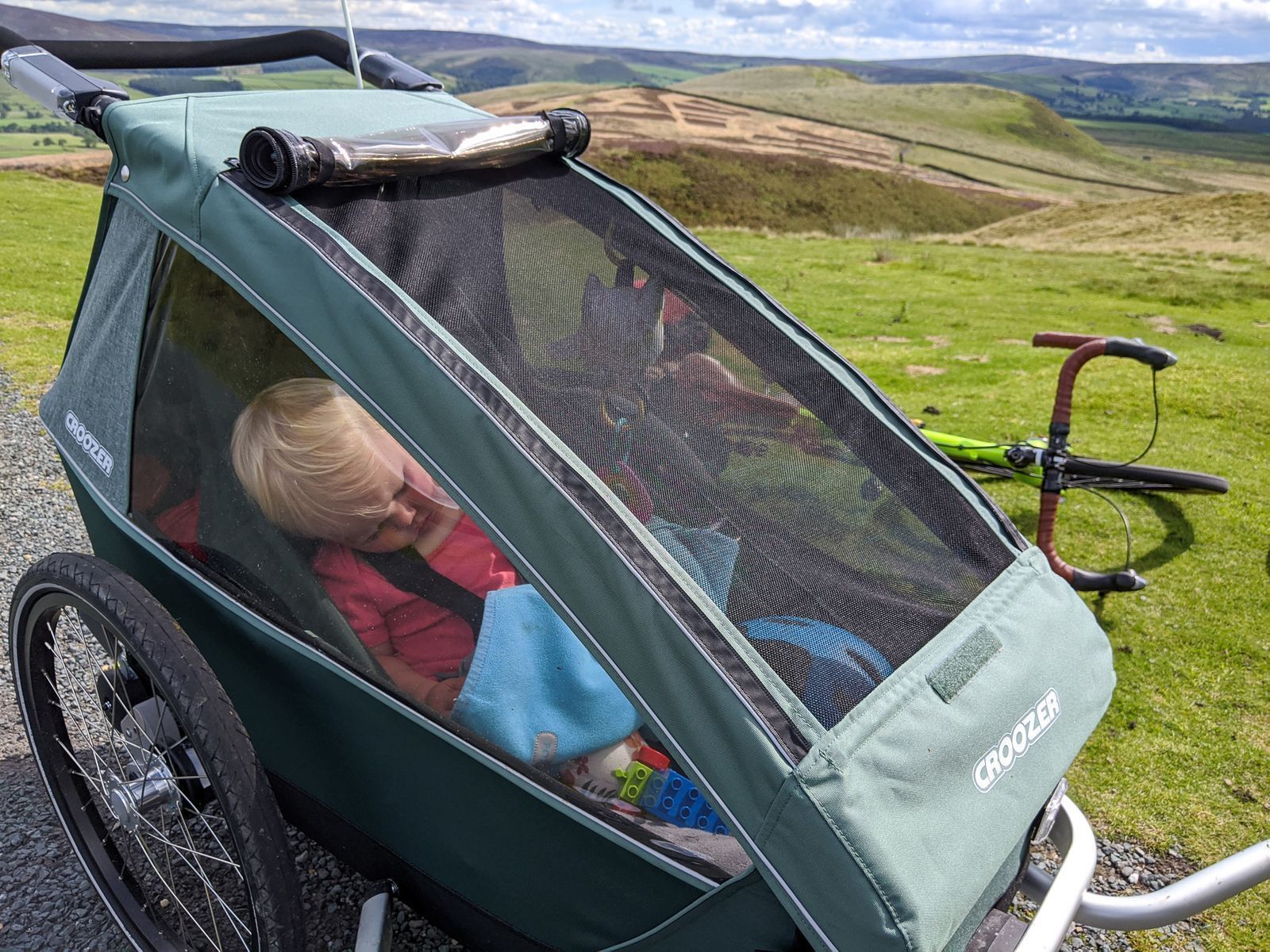
Weather has stayed out, even on some truly filthy rides, although the bottom of the bags in the boot got a bit damp and muddy, as they sit on top of a large mesh vent. It’s better used as a trailer rather than a buggy – I found the handle a bit too narrow and the front wheel prone to jamming sideways – but it’s OK for occasional use.
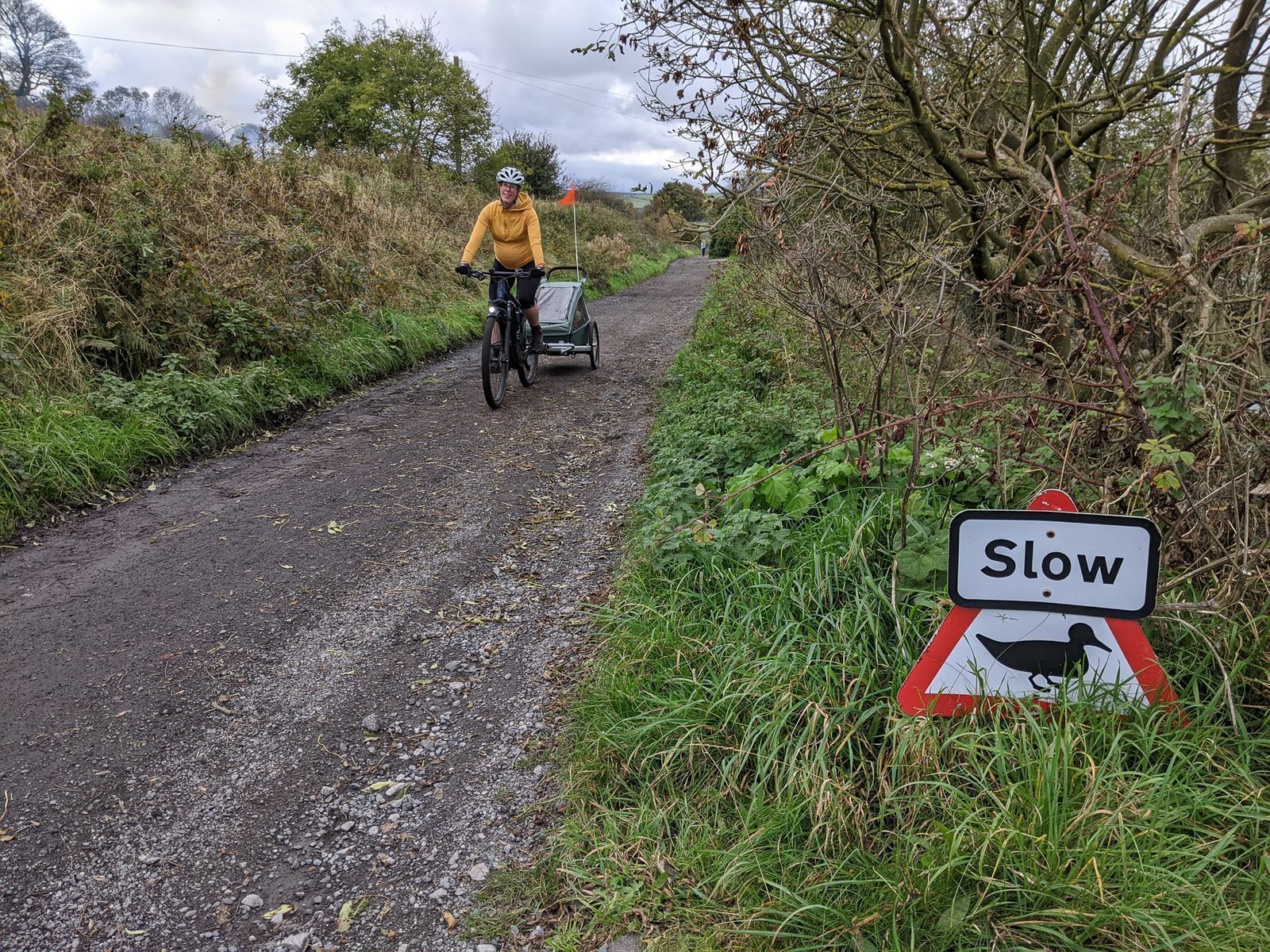
Durability Notes
The Croozer Vaaya has had a fair bit of use over summer and autumn, and there have been no issues to speak of. Croozer are confident enough in their product to offer a 3-year warranty on the trailer fabric and a 10-year warranty on the frame. The problems I’ve had relate more to bedding in, such as the sticky catch for the hitch mentioned above. The cover is also very tight on the frame, and even after using it for a few months I still struggle to pop it into shape.
Croozer Vaaya 1 Specifications
- Dimensions // L 110cm x W 72cm x H 95 cm
- Weight // 15.9 kg/35.05 lb
- Max passenger weight // 35 kg
- Max passenger height // 117 cm
- Load capacity // 35 kg
- Price // €950
- From // www.croozer.com
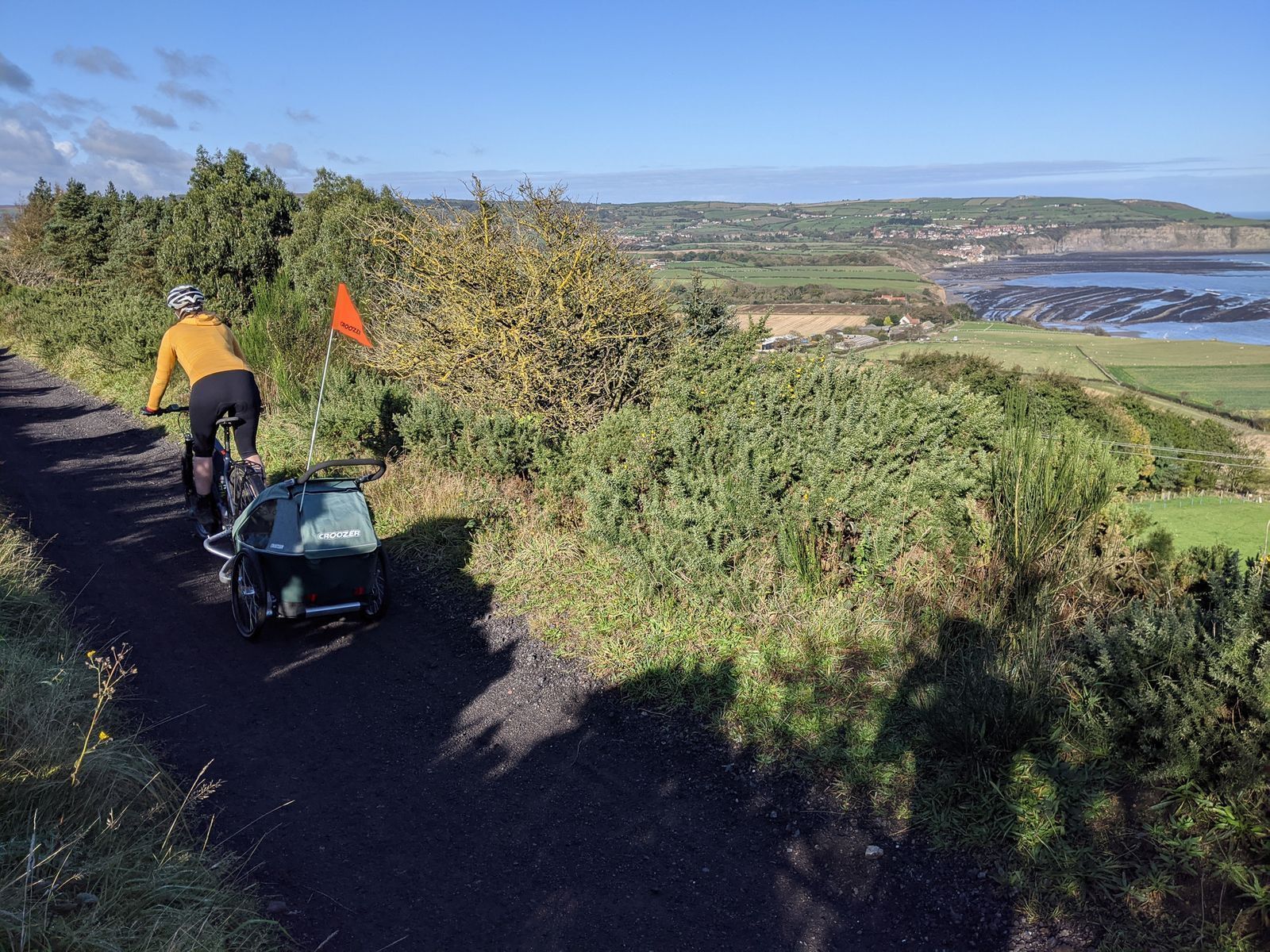
Overall
The Croozer Vaaya isn’t cheap by any means, but it’s a great quality, versatile trailer that will hold its resale value much better than most bike-related things. For proper off-road singletrack, you’d be better off with a bike seat or a single wheel trailer. But if you want luggage capacity, weather protection, or something that can carry younger children, it’s very dependable way of getting out there.
Comments (3)
Comments Closed

What a neat combo. Maybe just add a slackerizer headset and a Totem up front and you’re sorted.
You’re never going to be bombing it down rocky trails on a touring bike like that so I think the “lack of modern off road geometry” is overstated.
Thebrick, that’s assuming that you can choose the ideal terrain for it. A lot of “gravel riding” in the UK is actually pretty rocky and blown out.